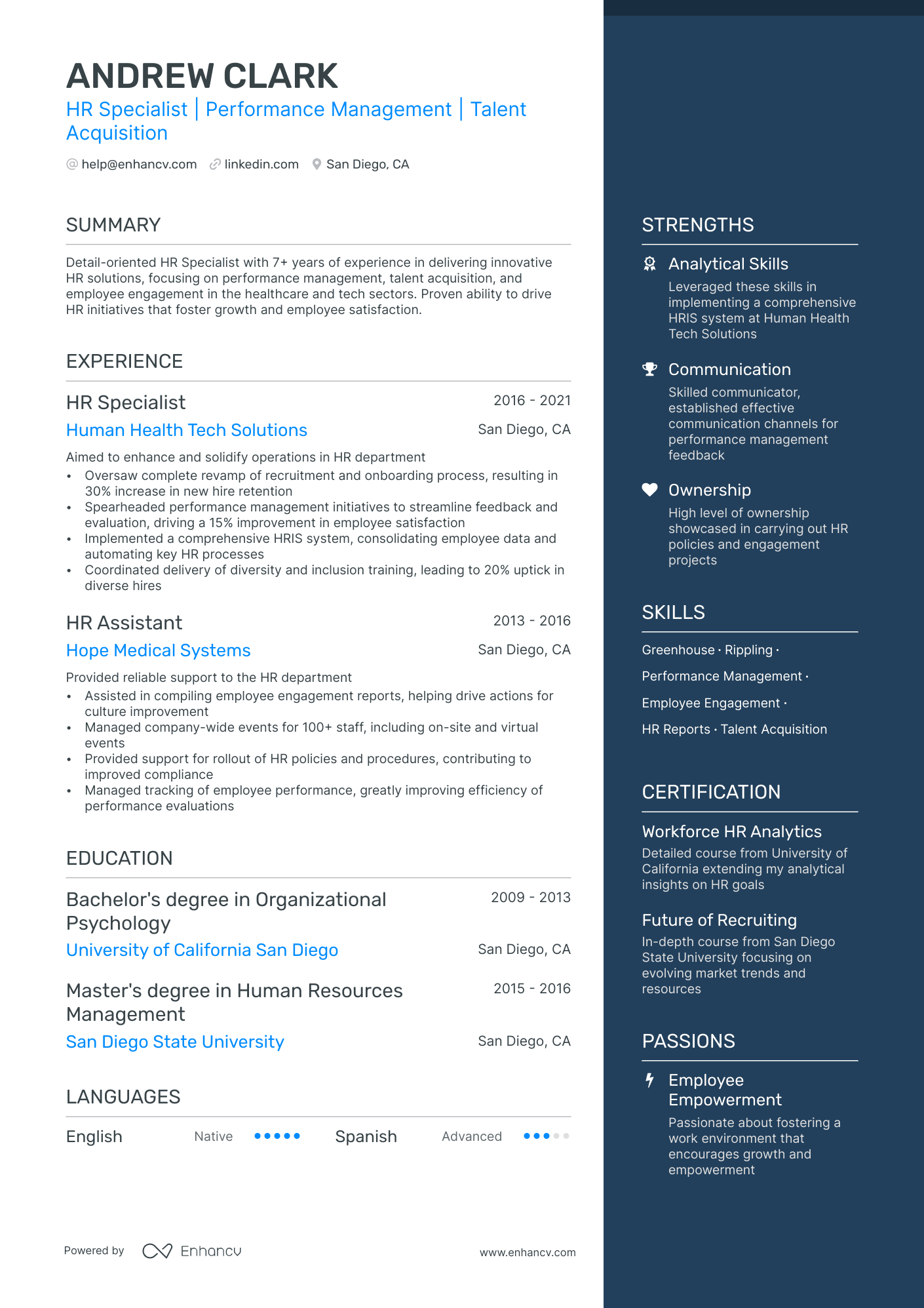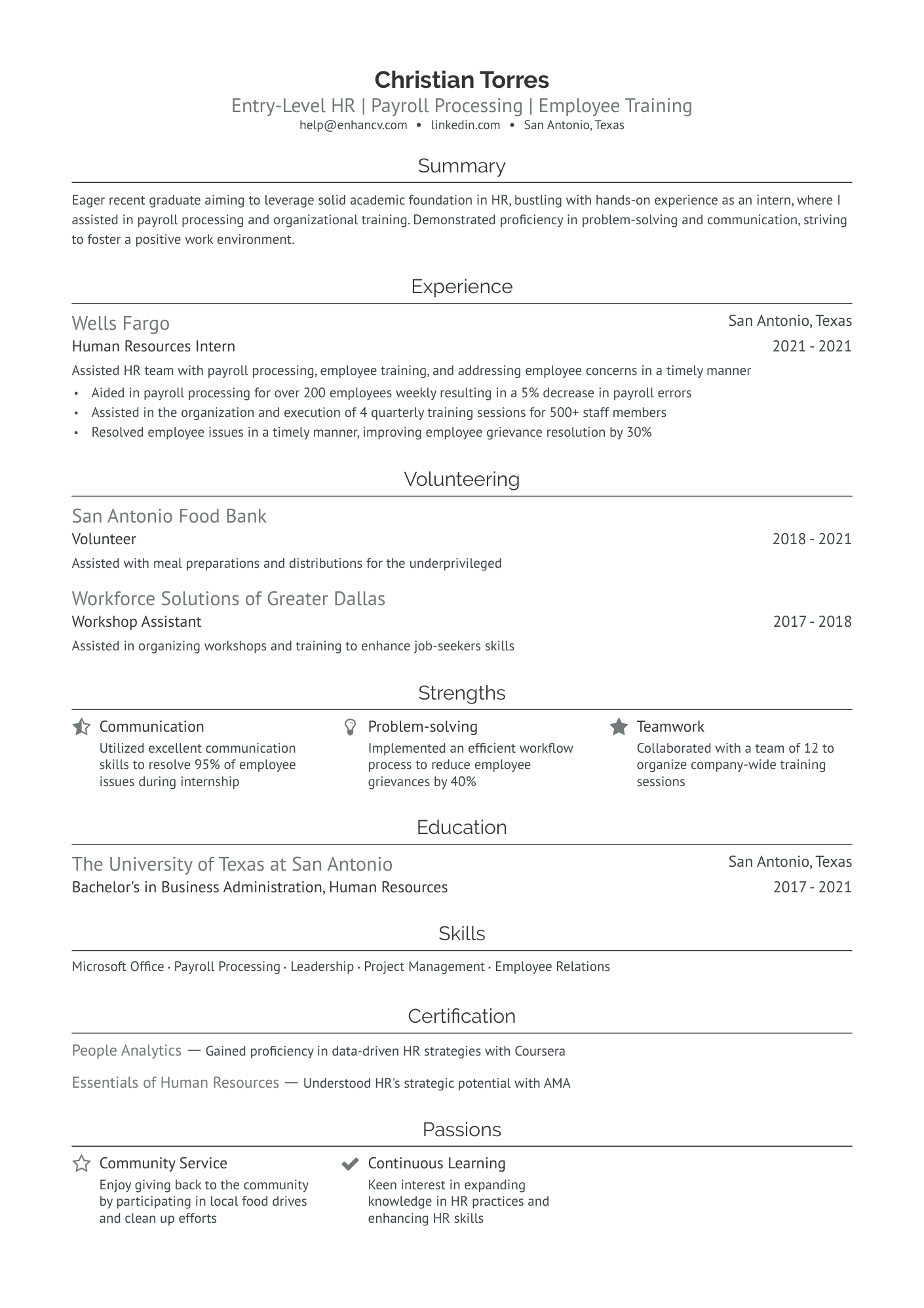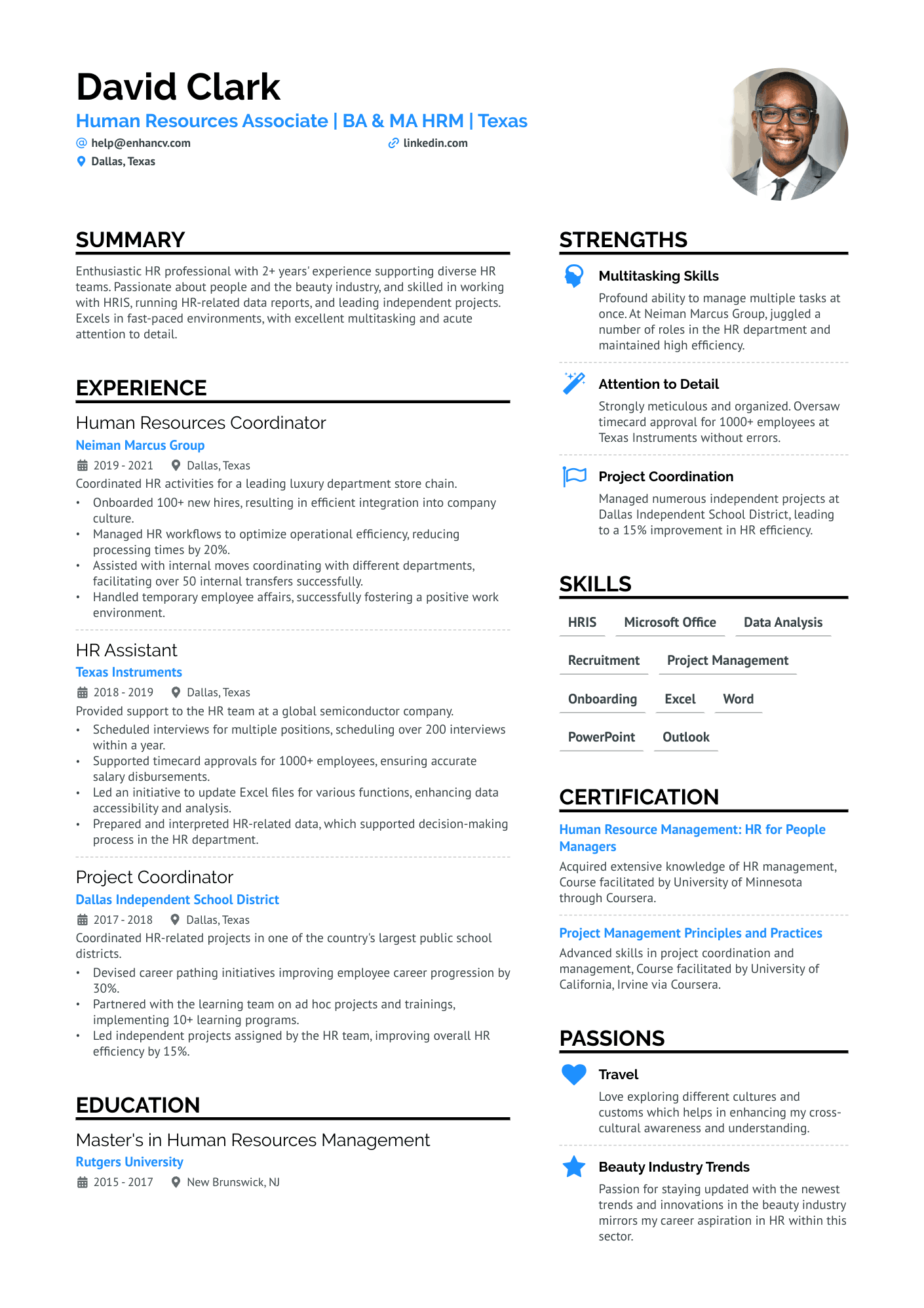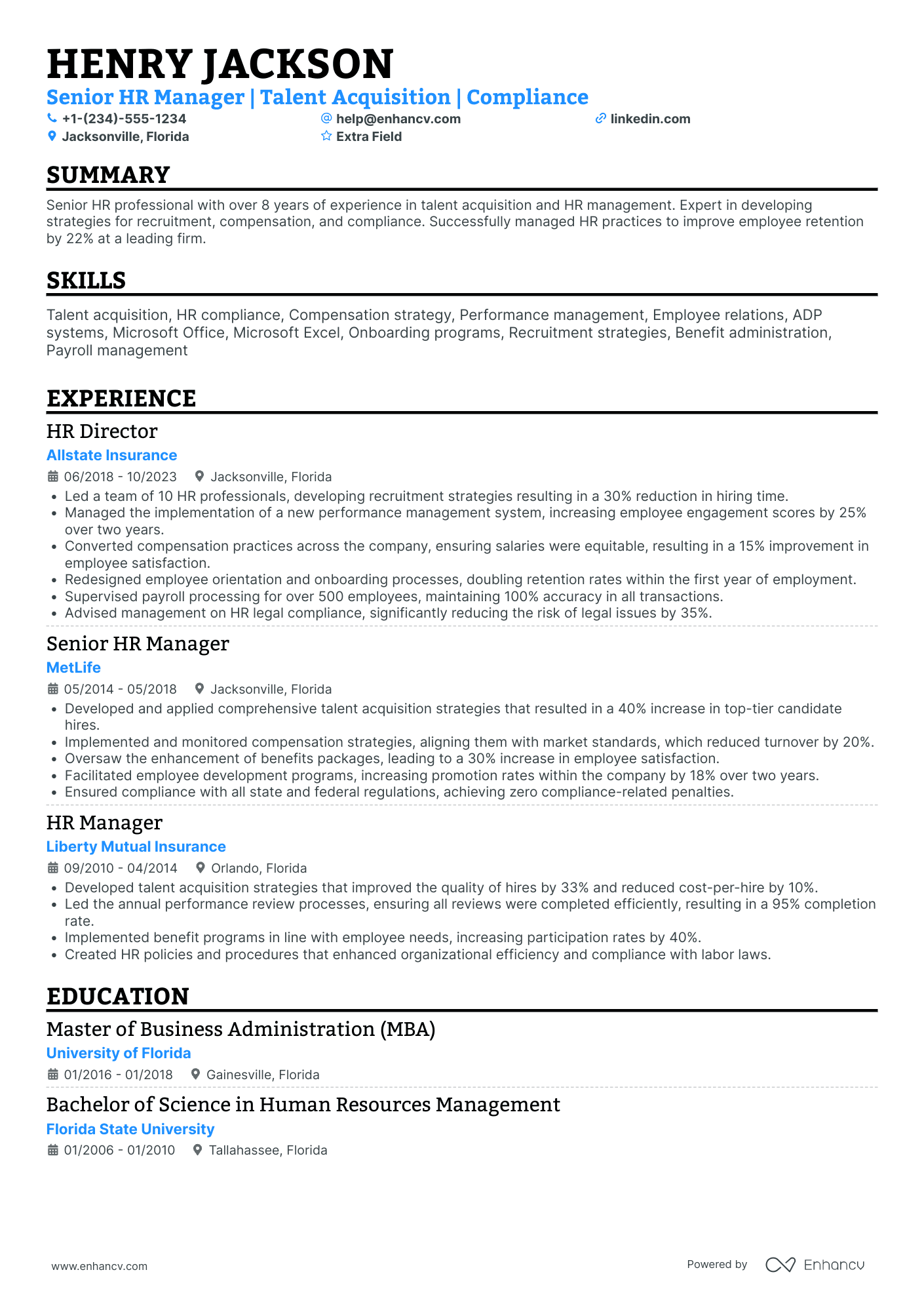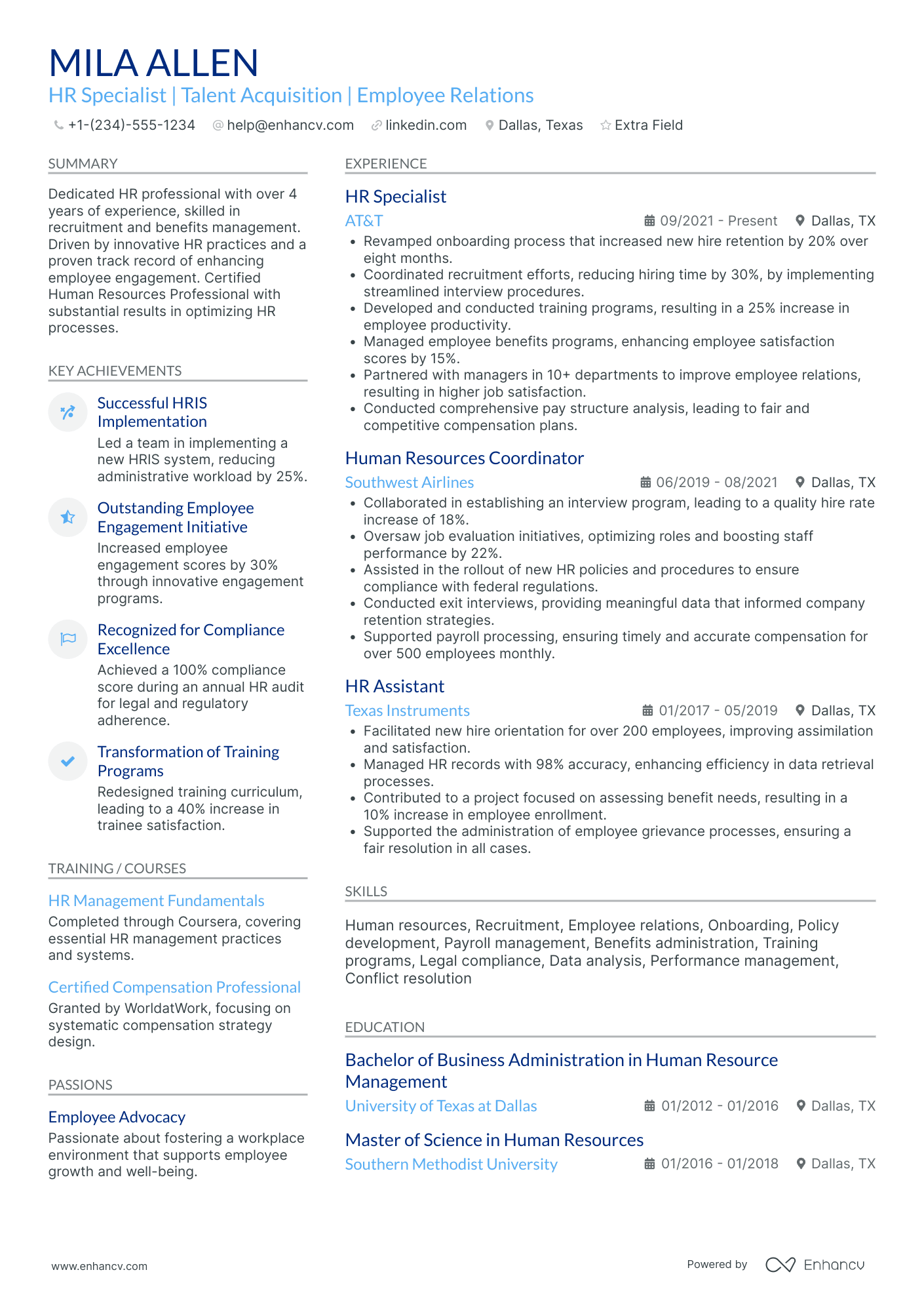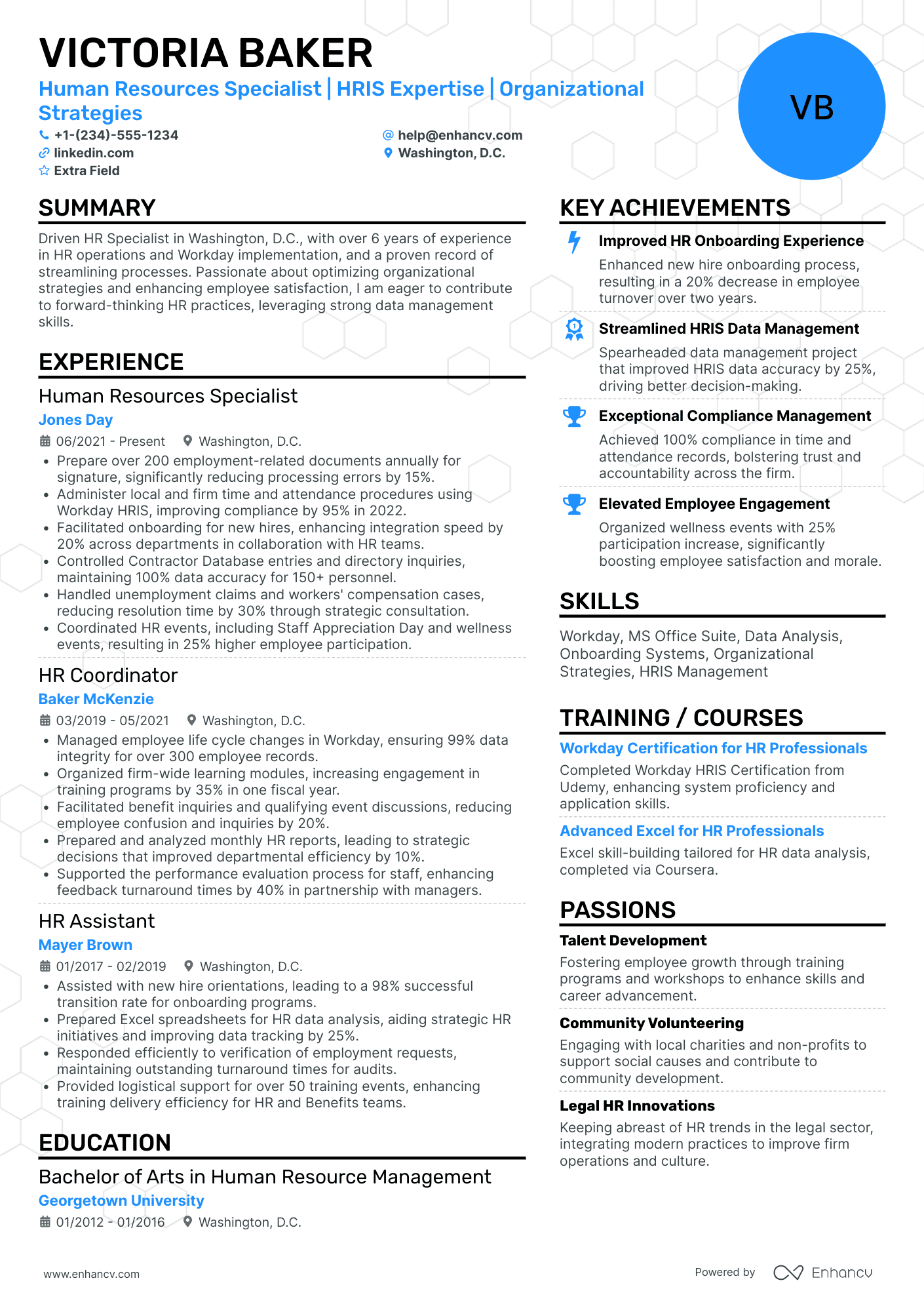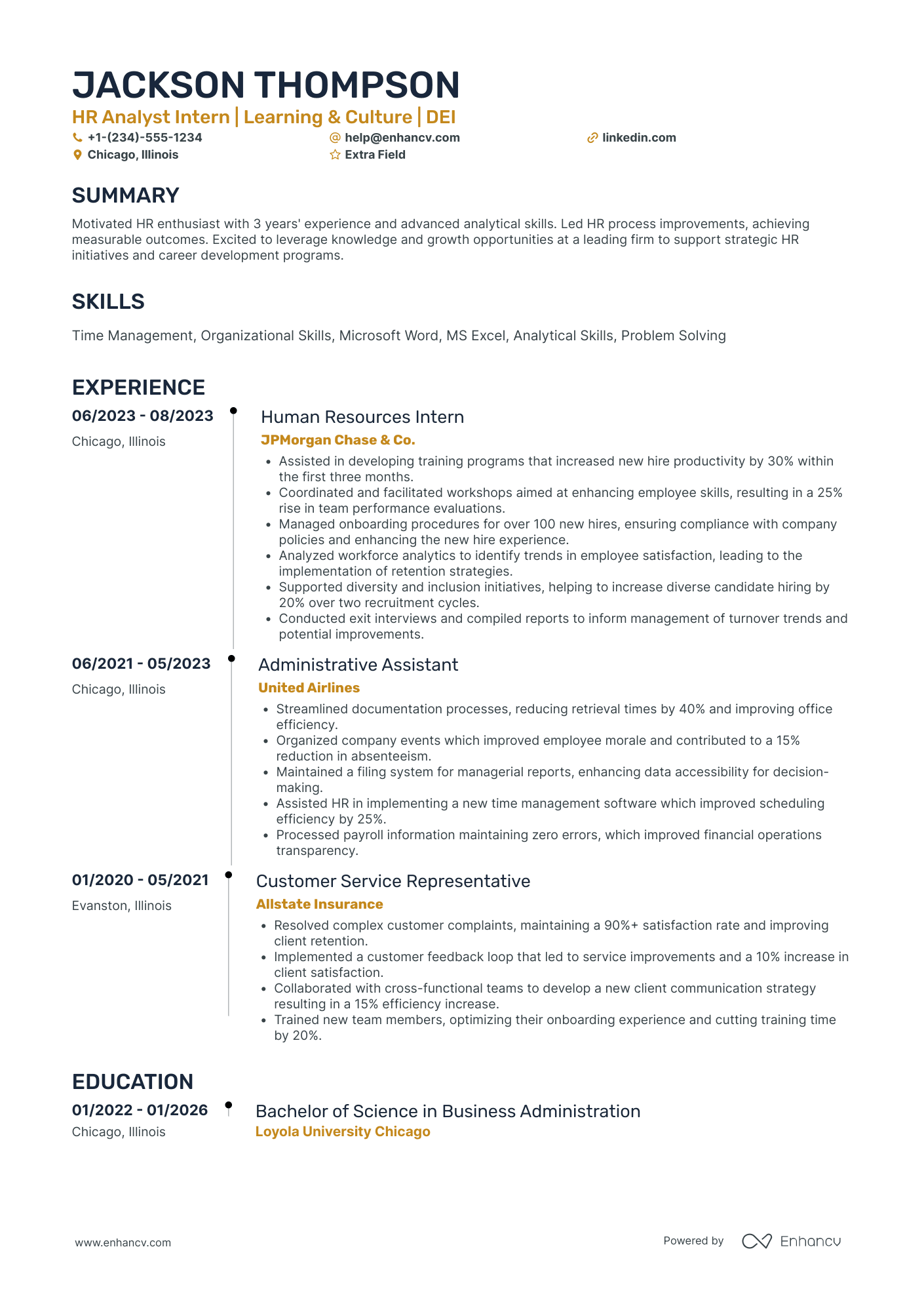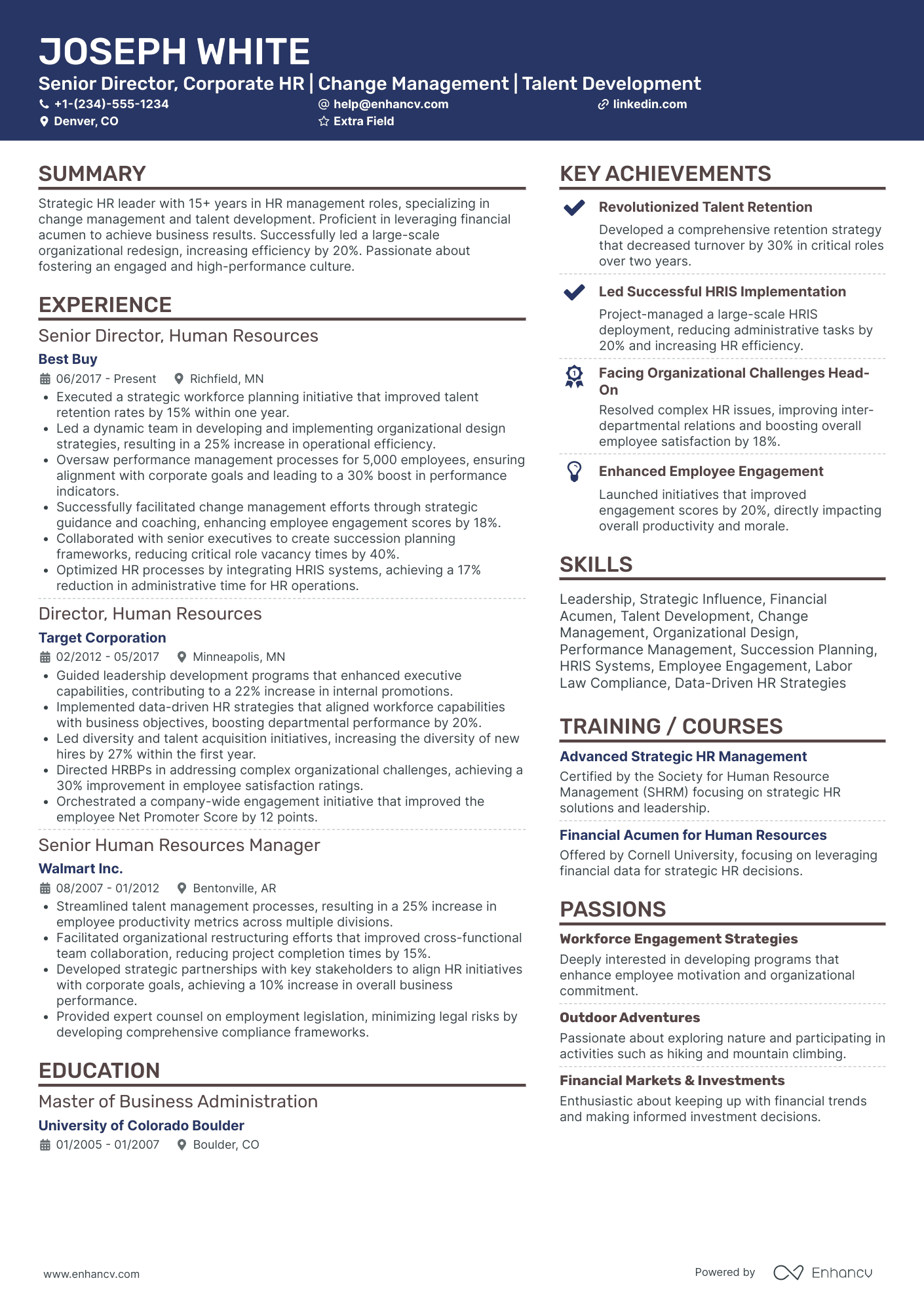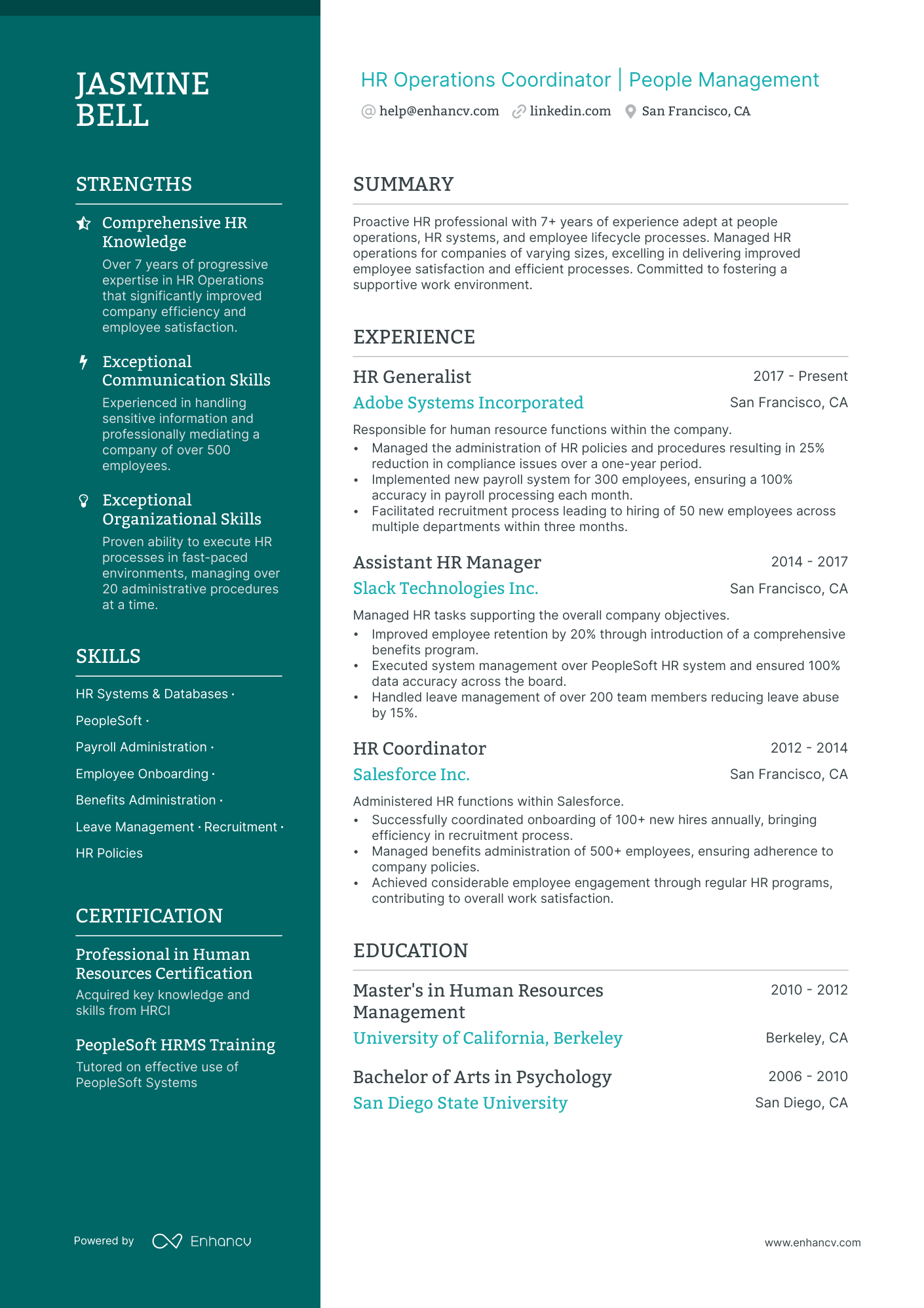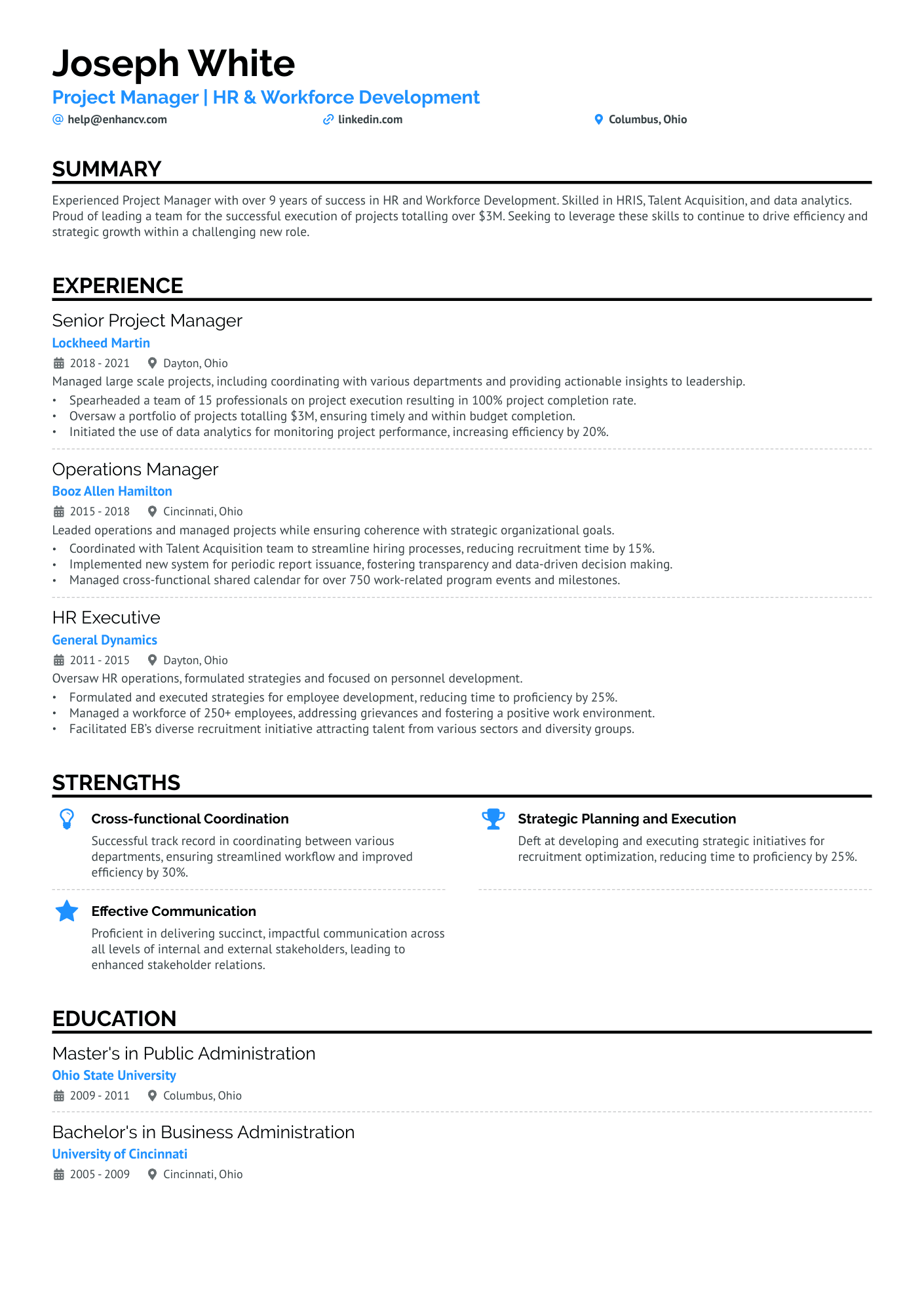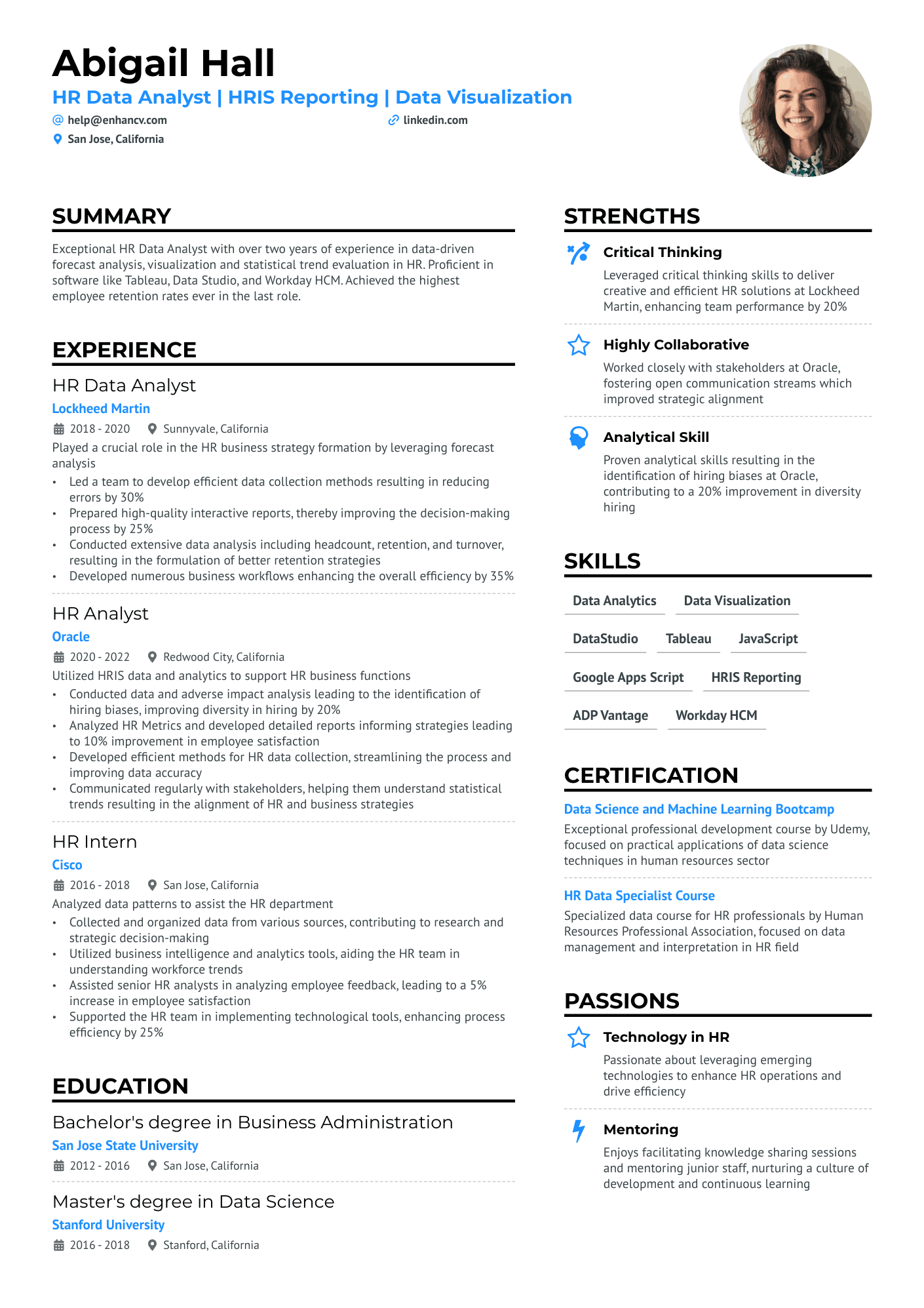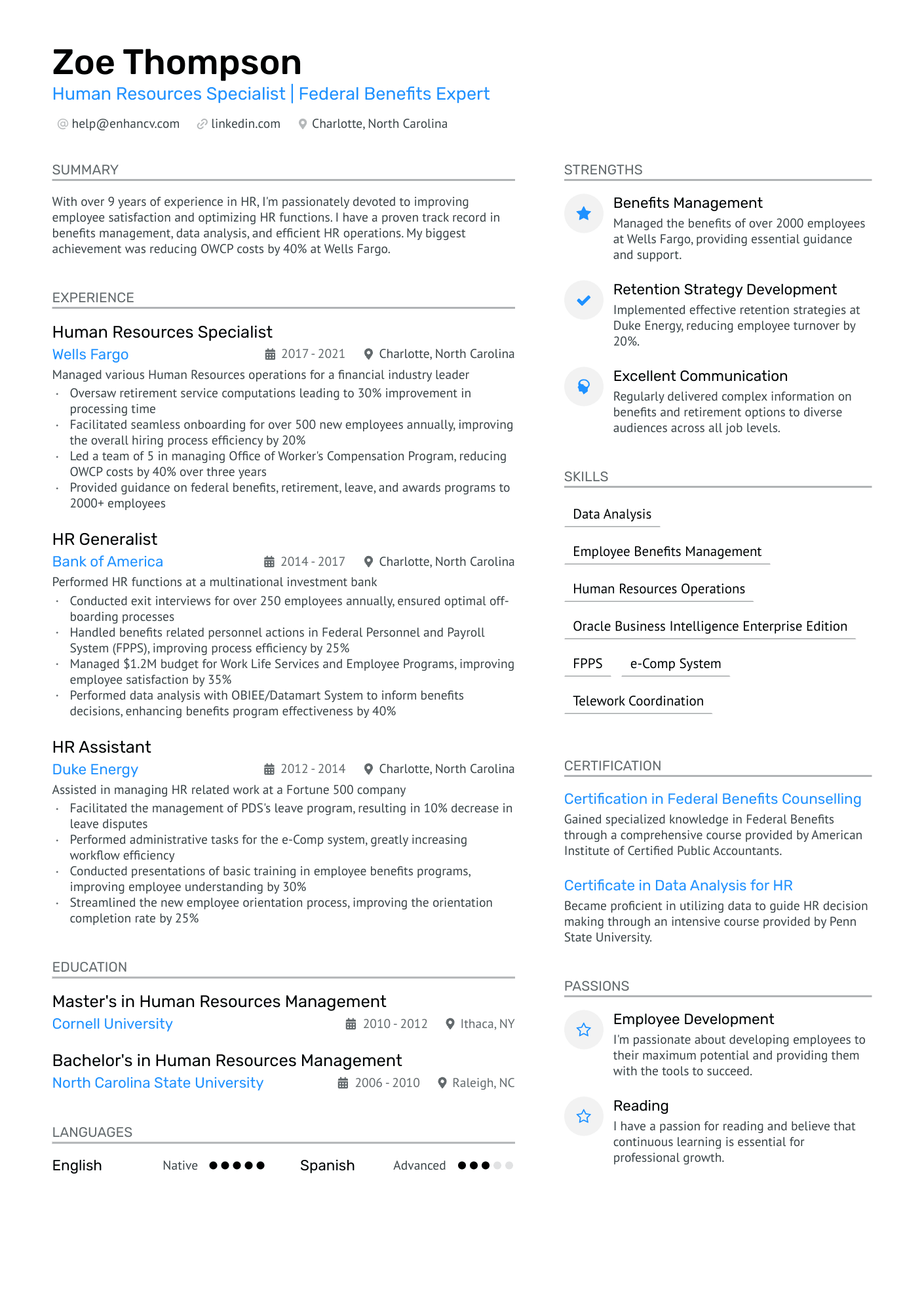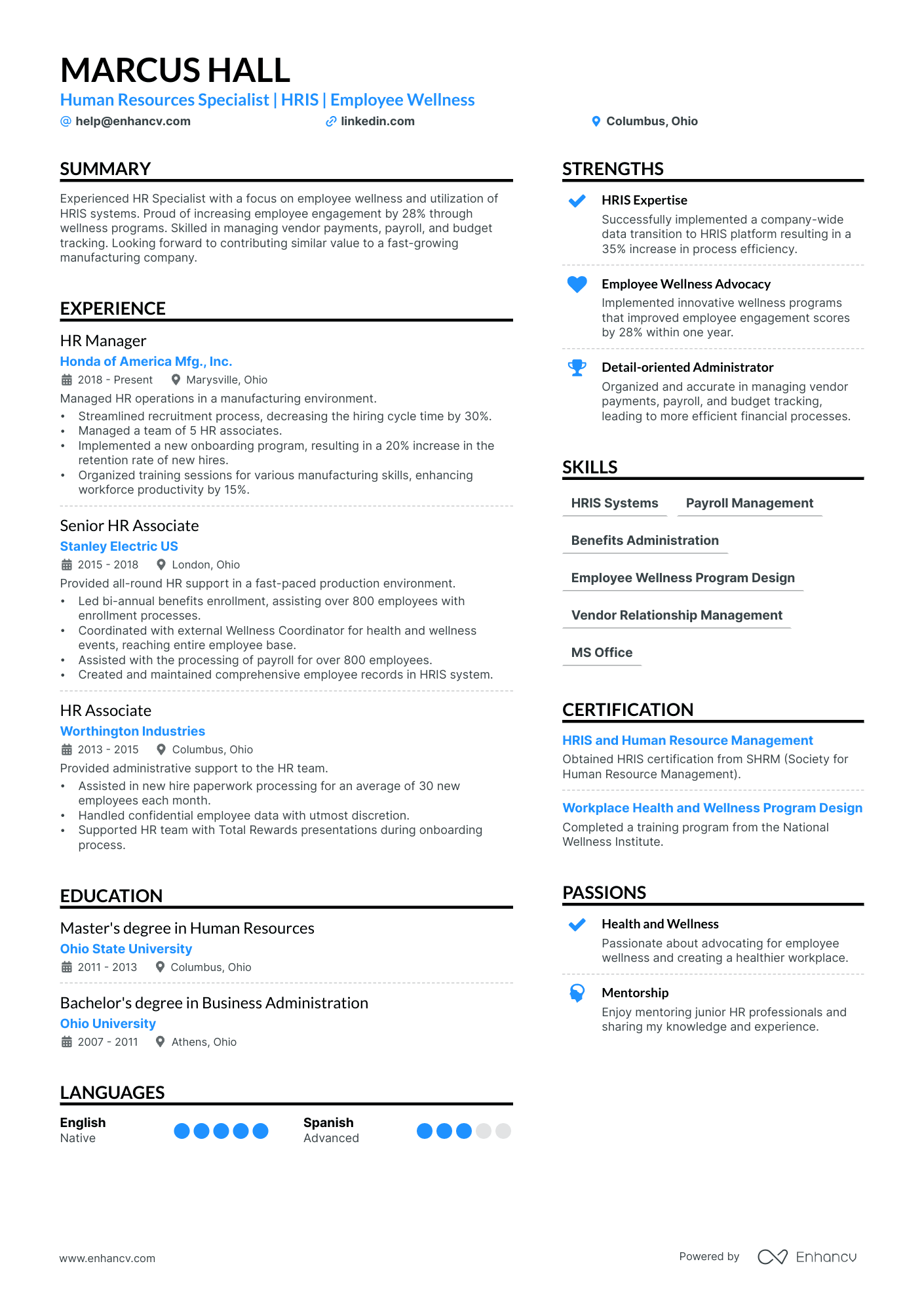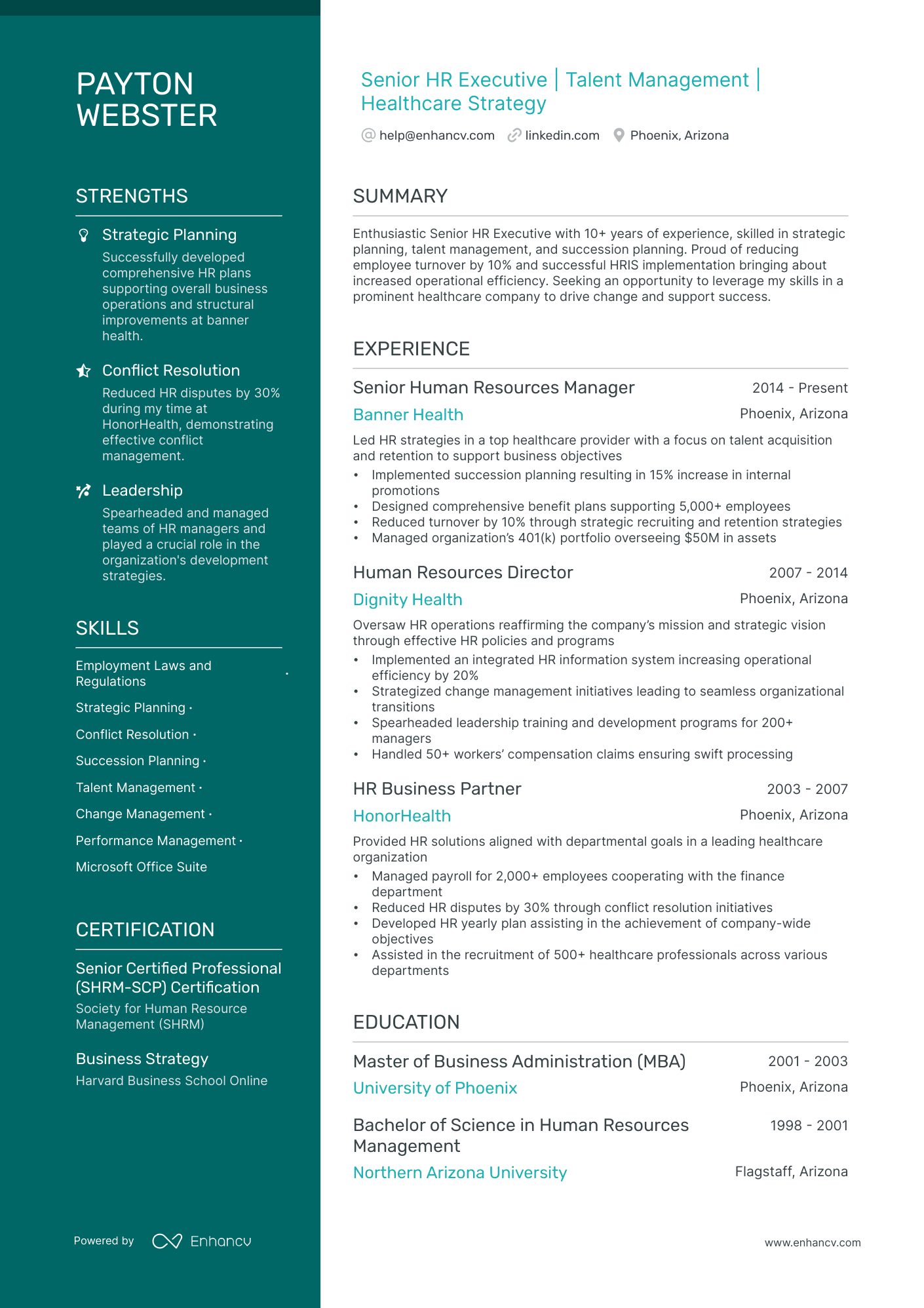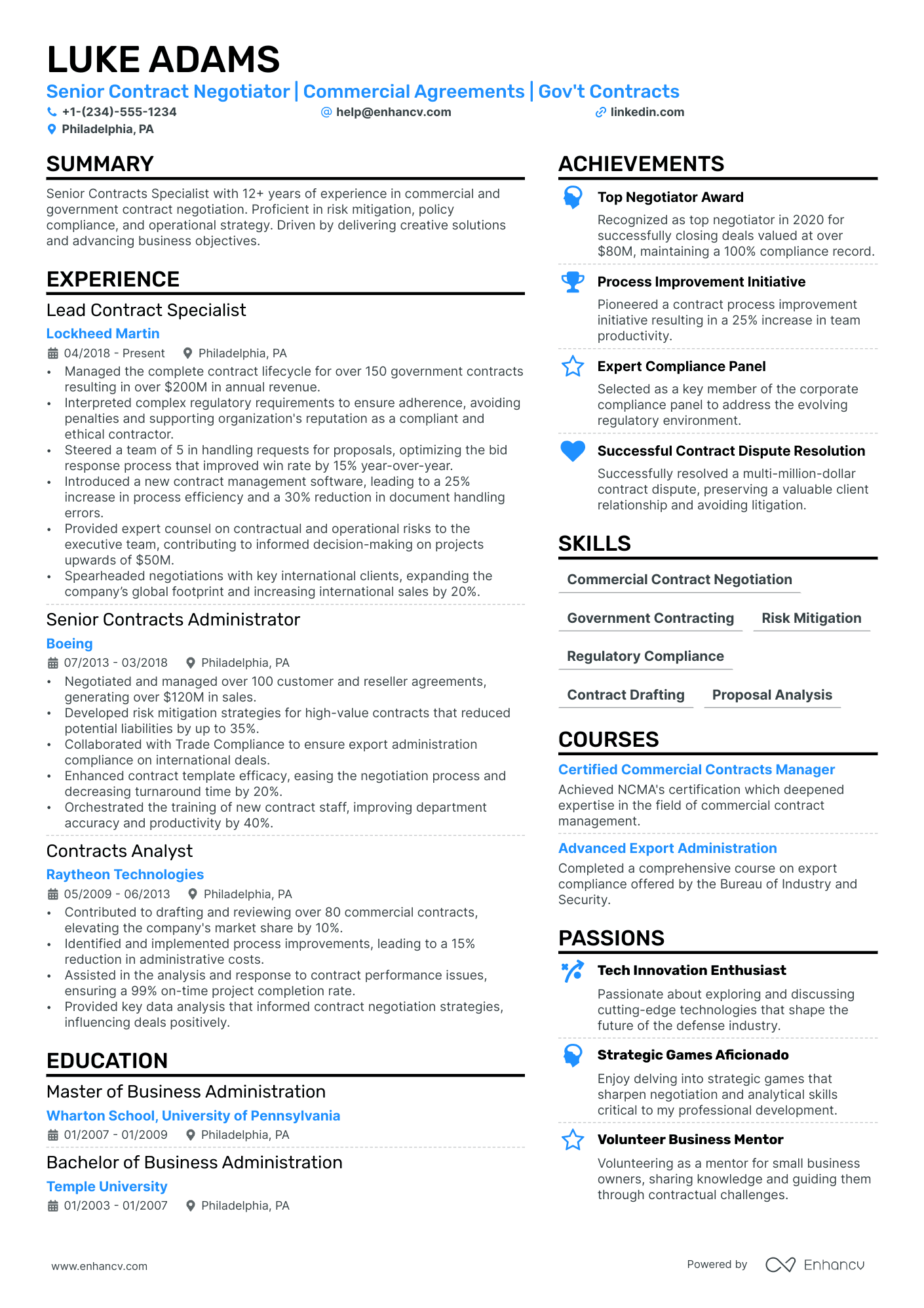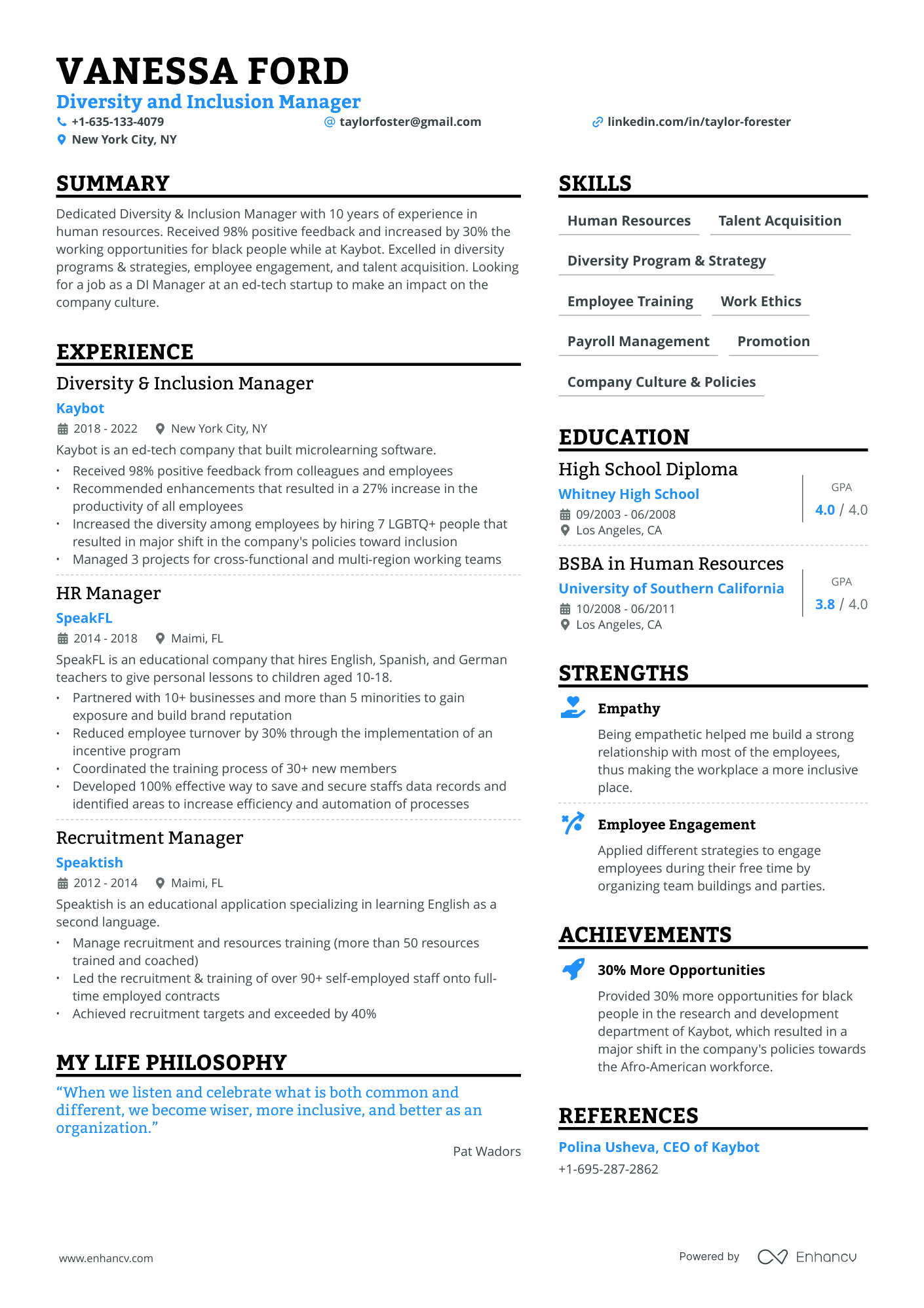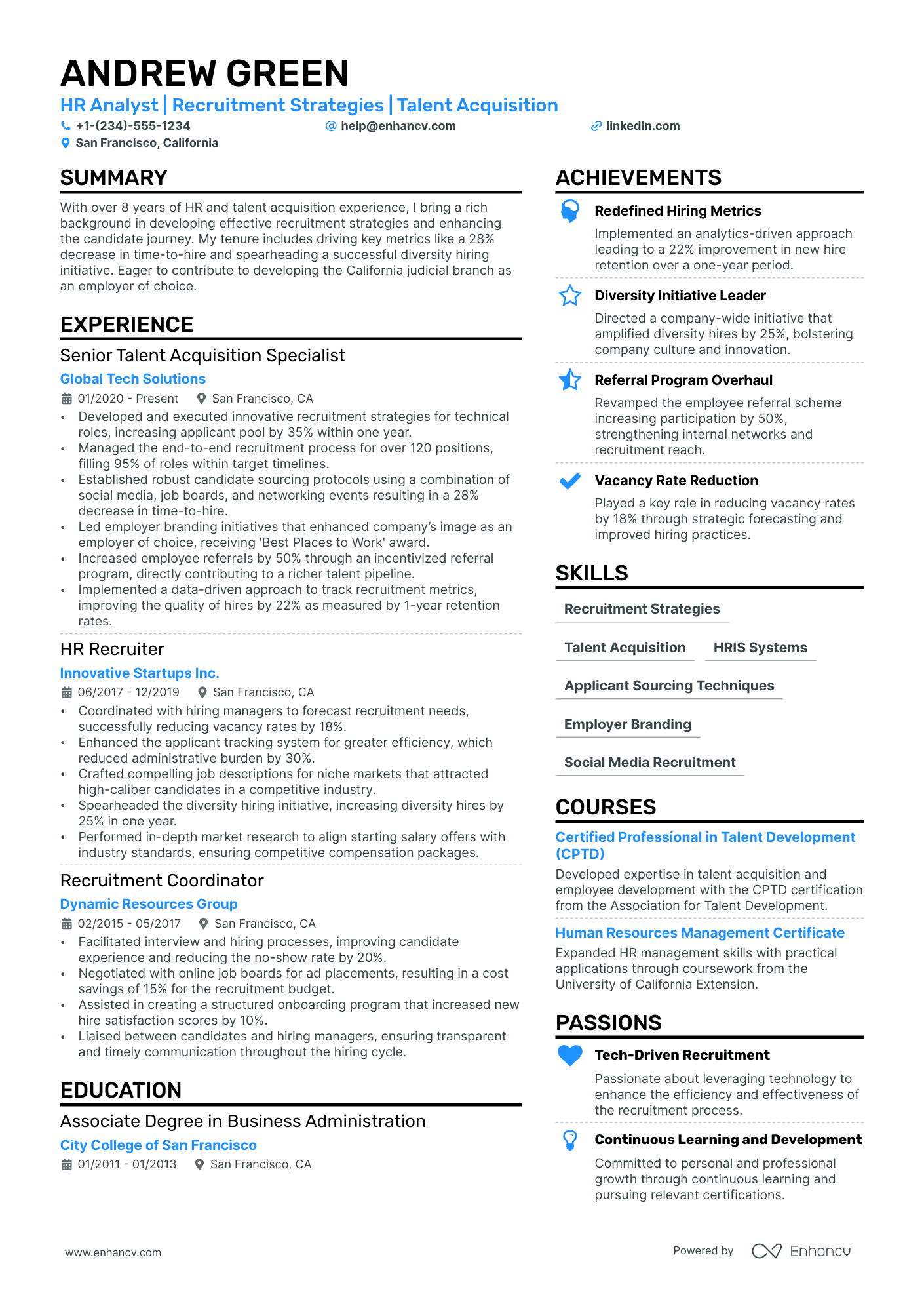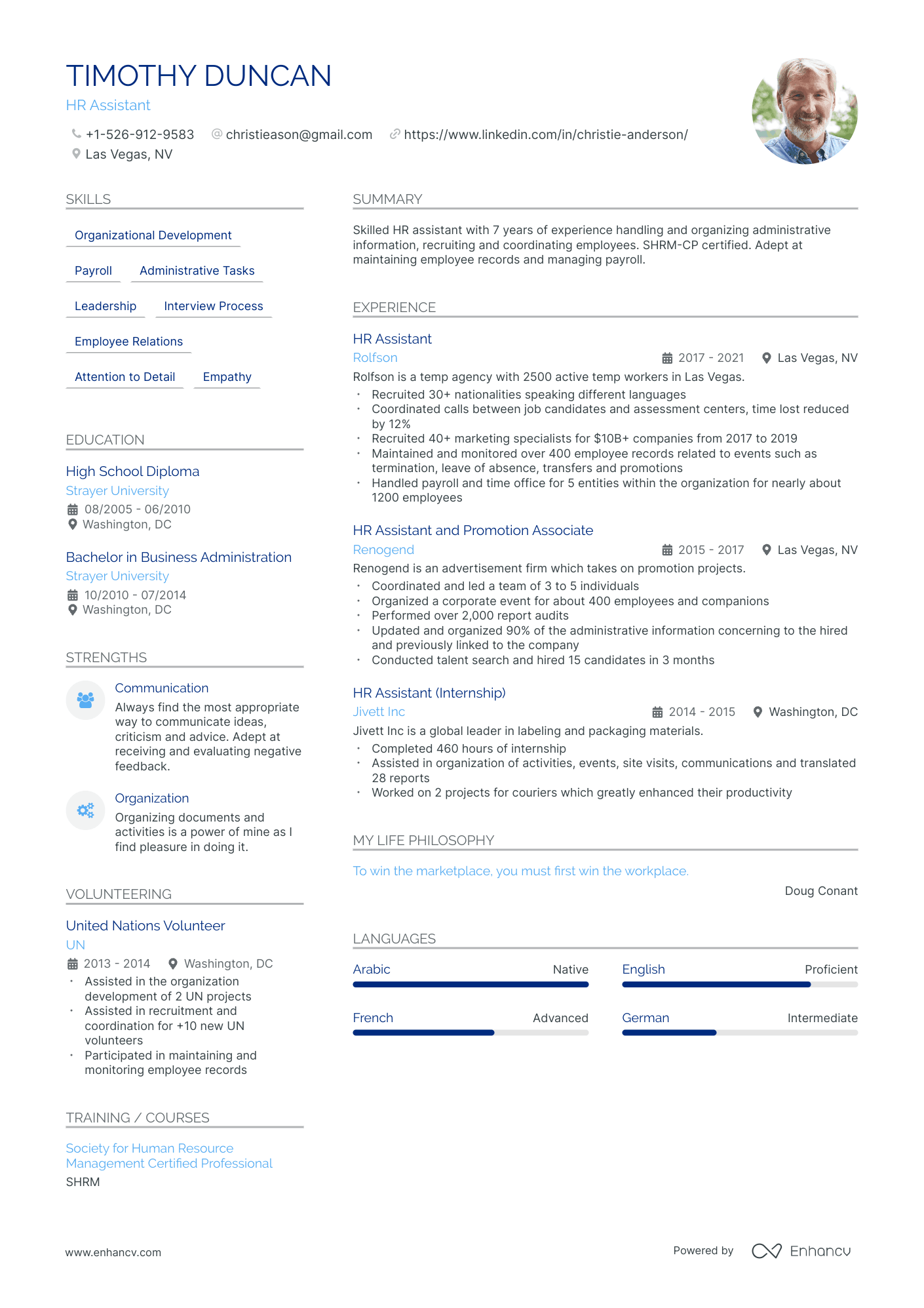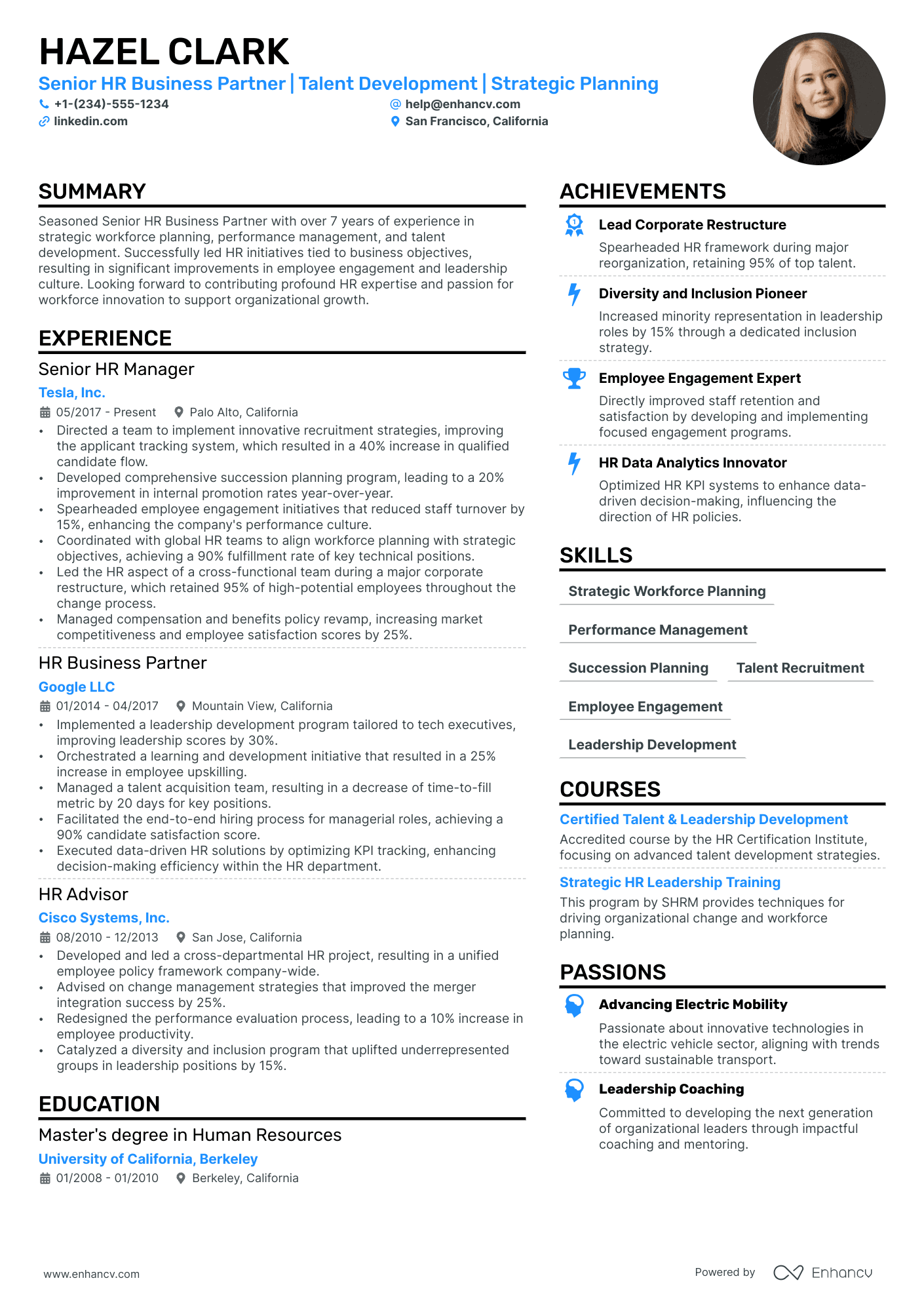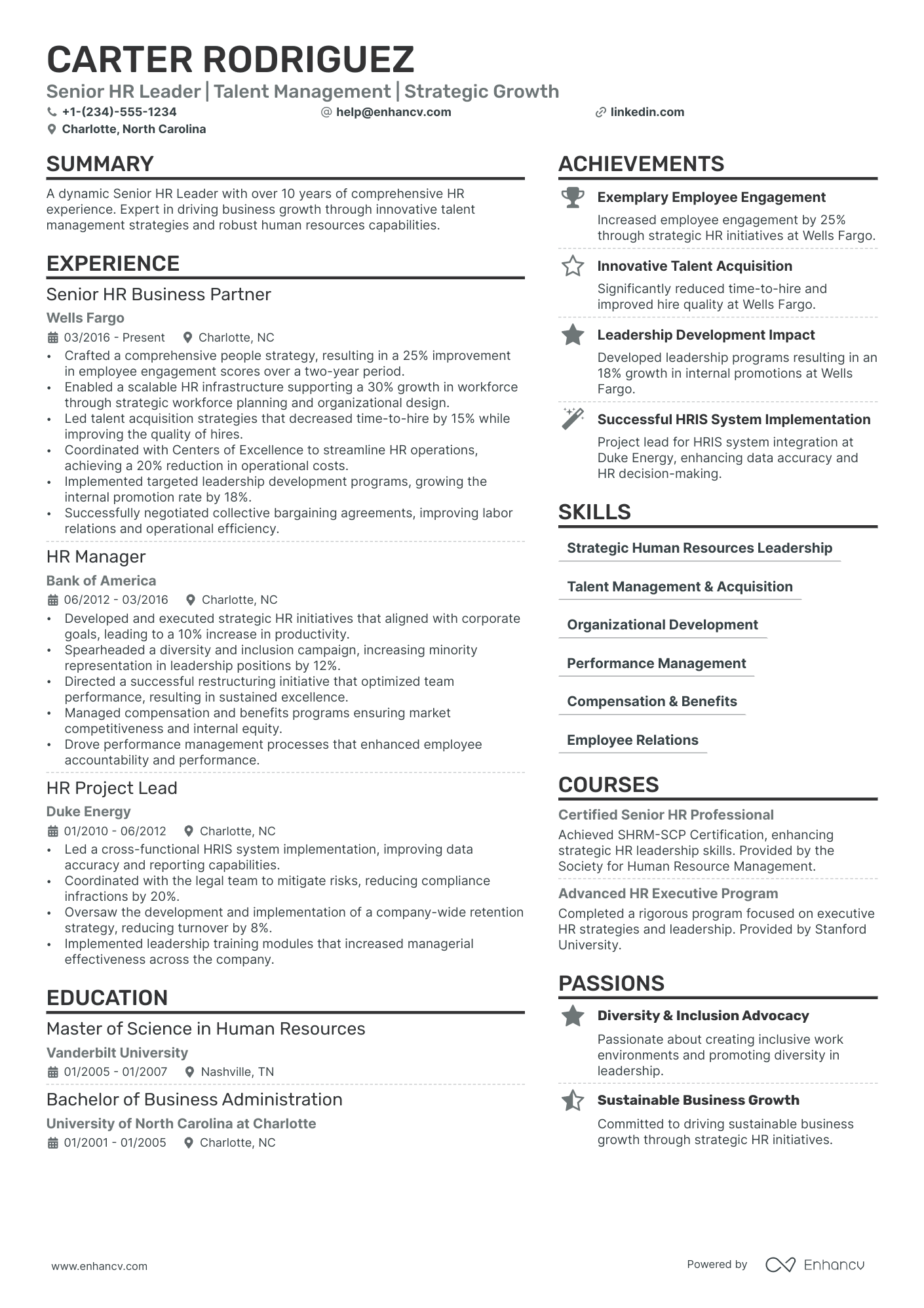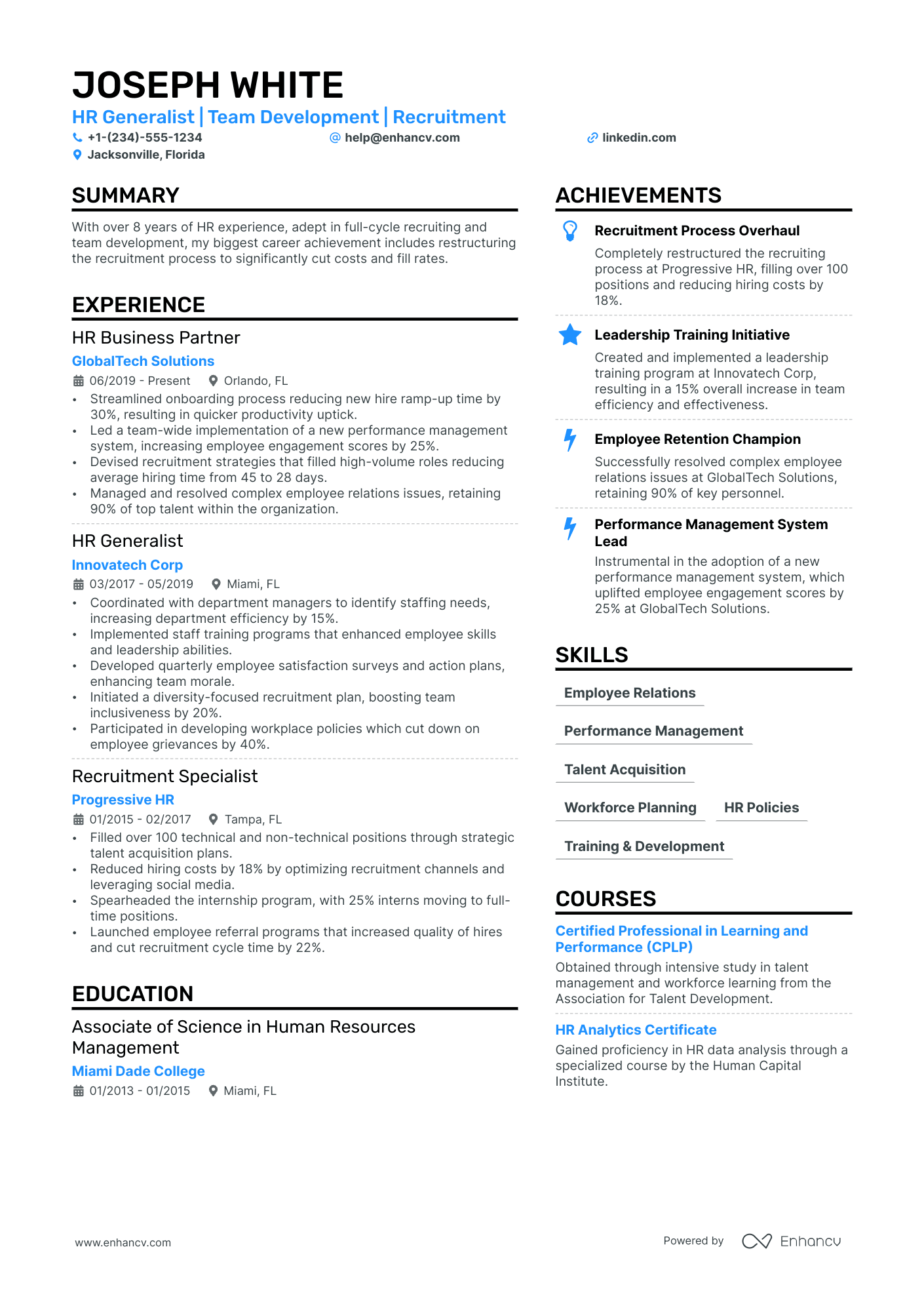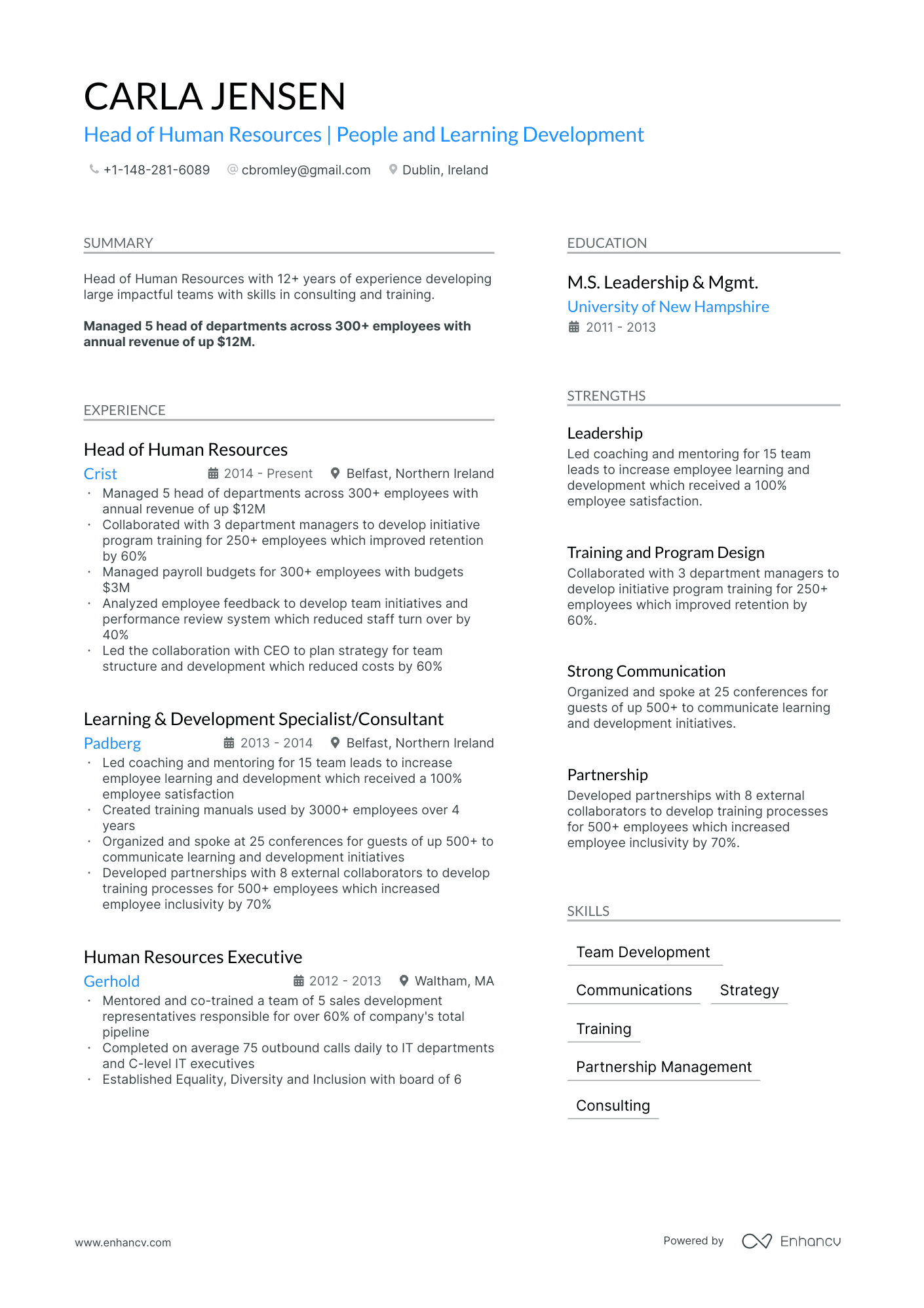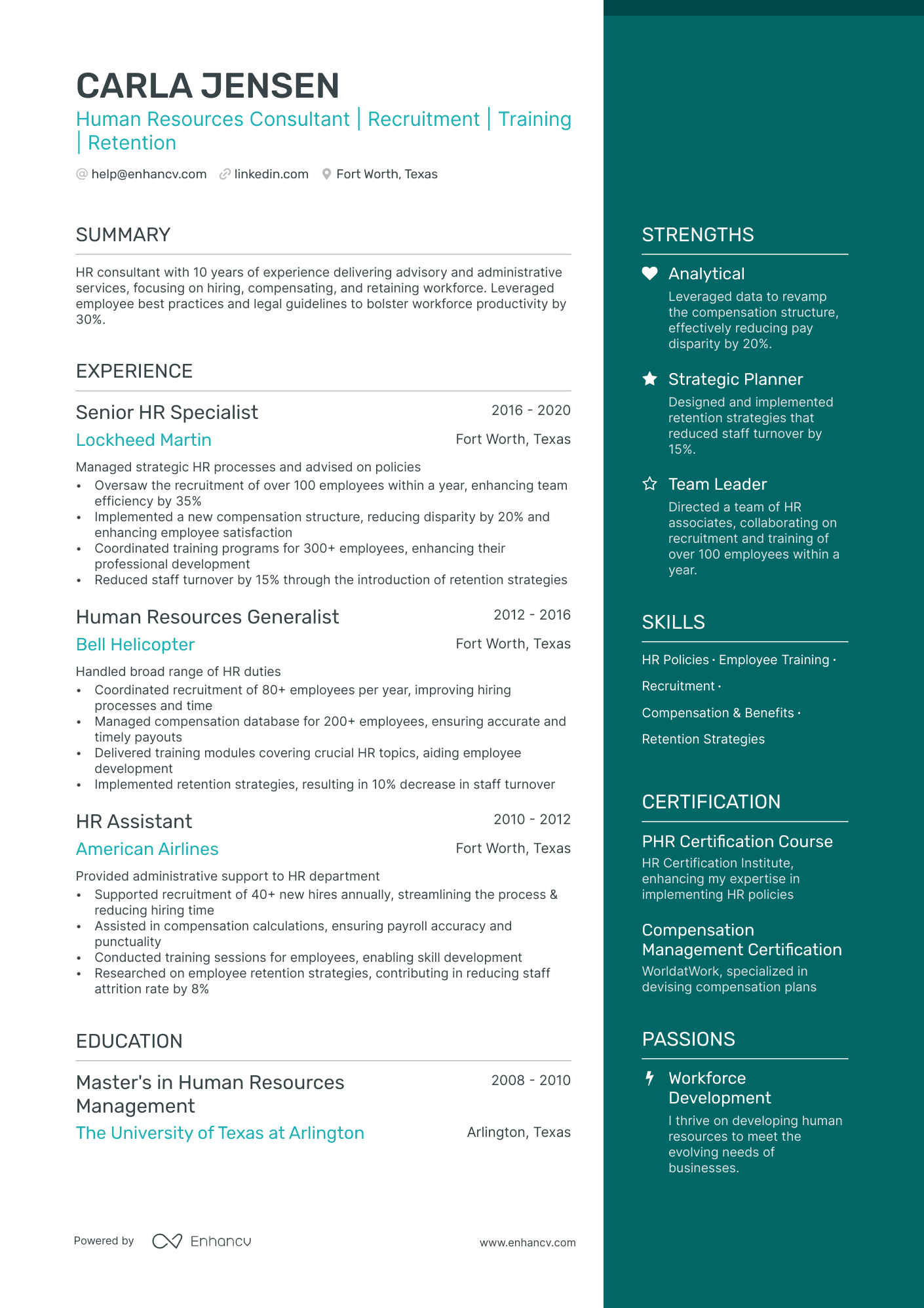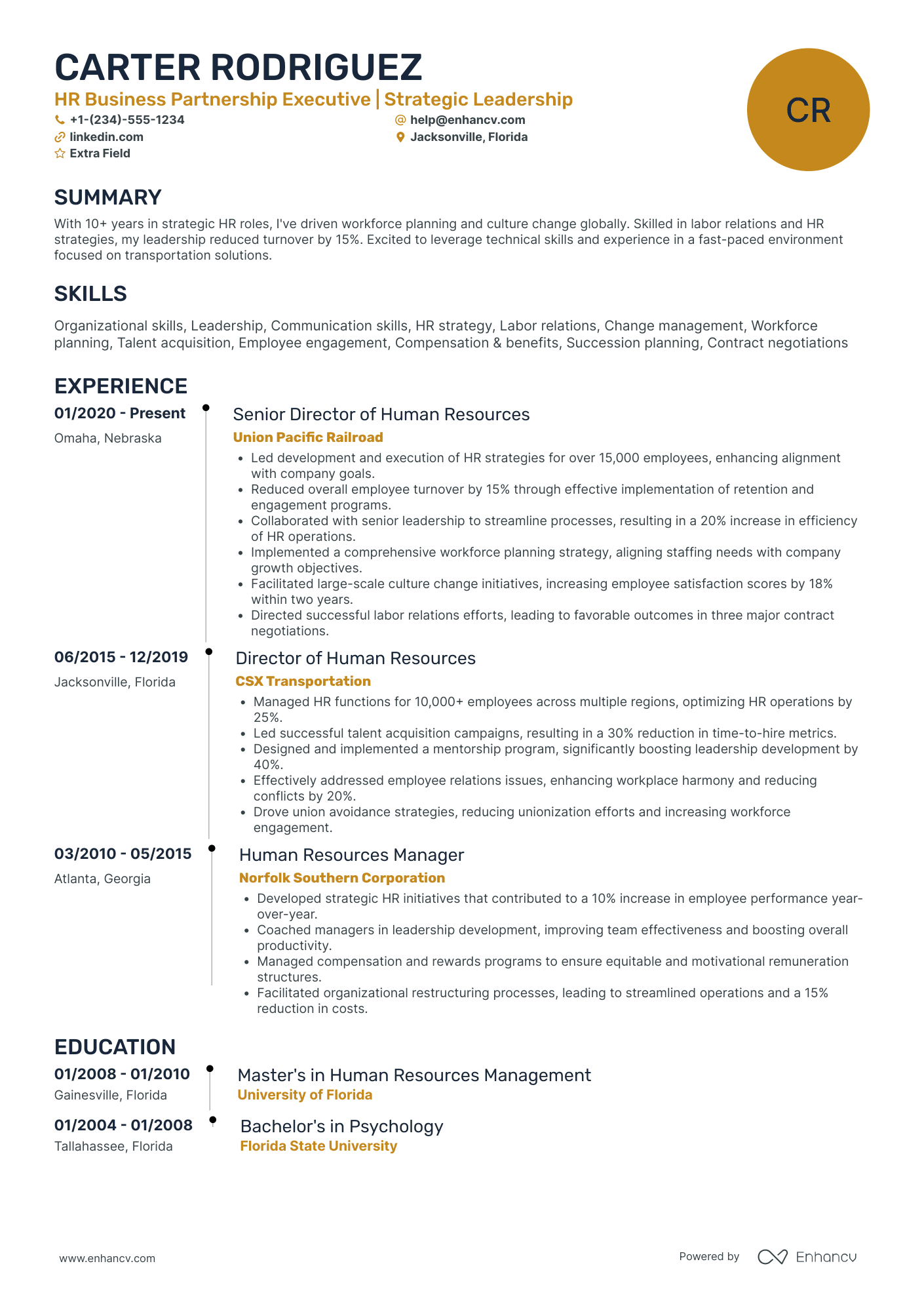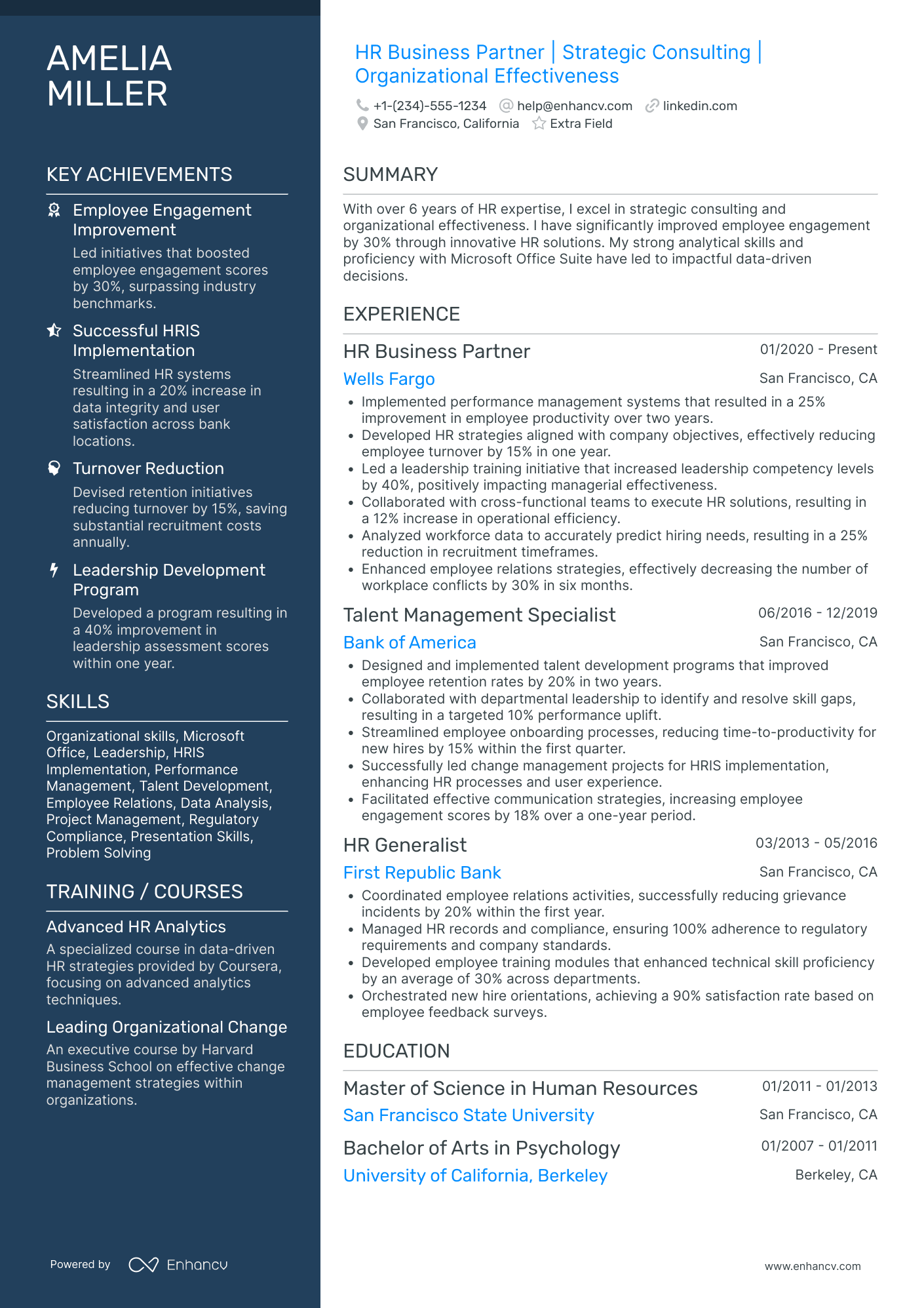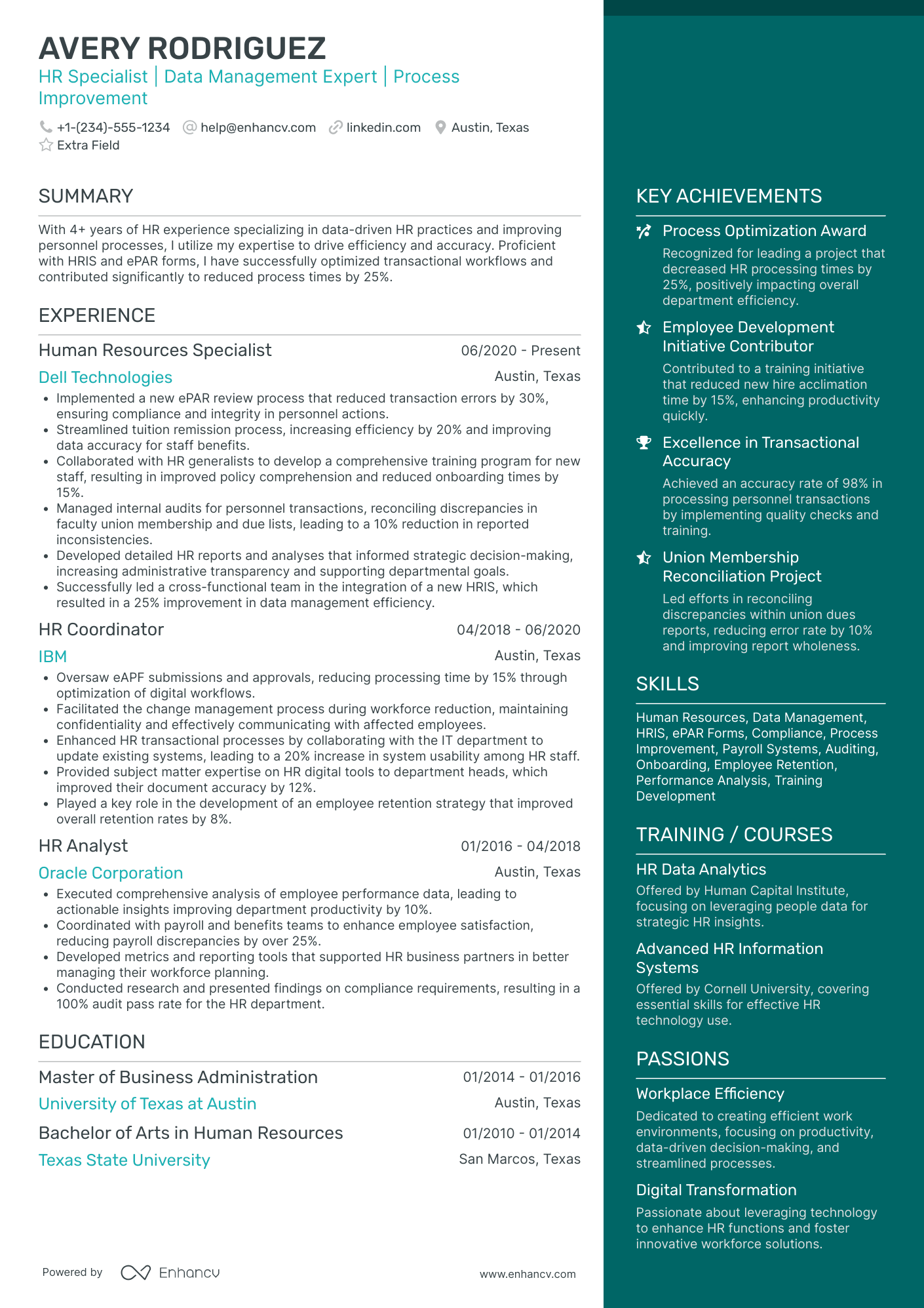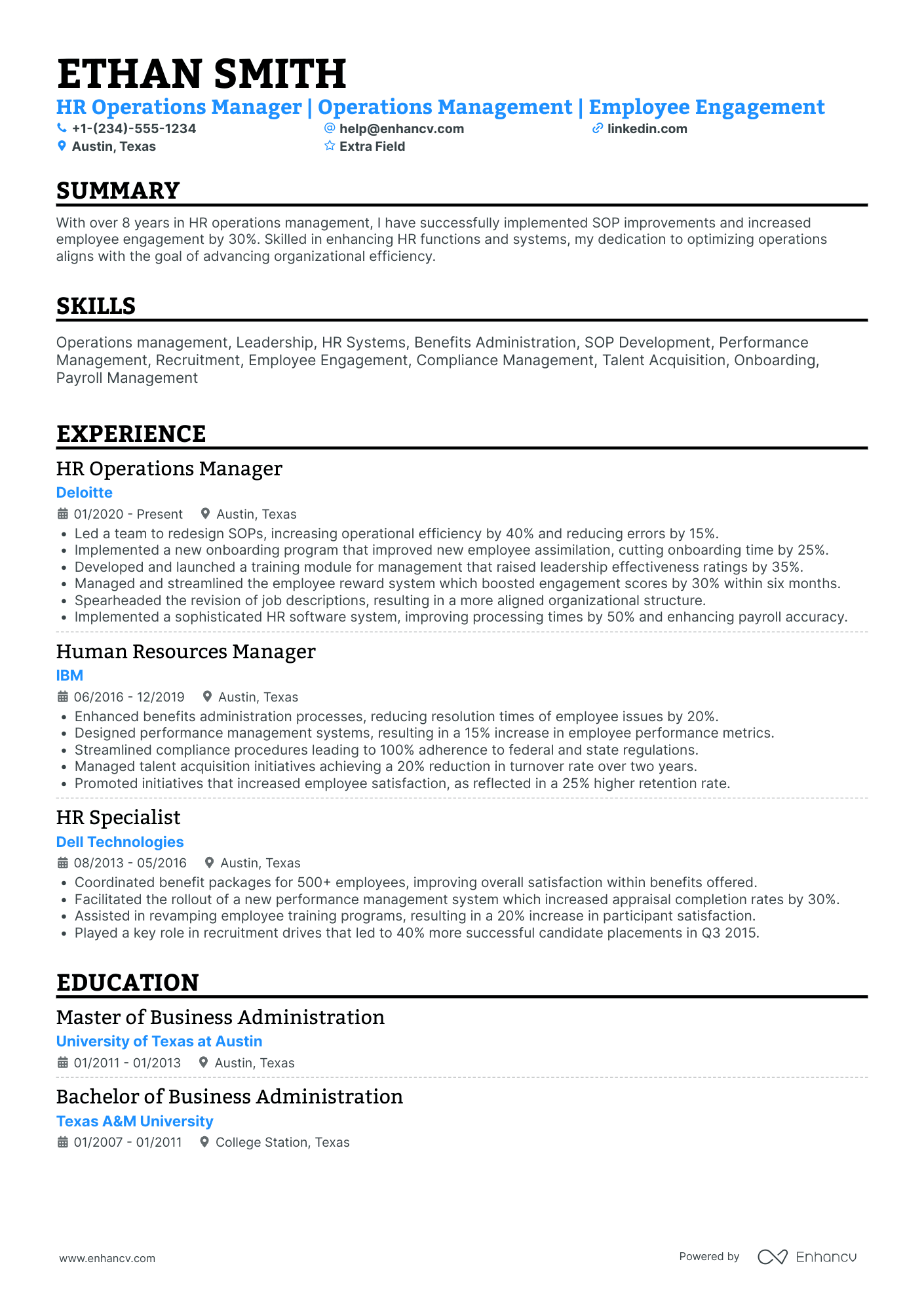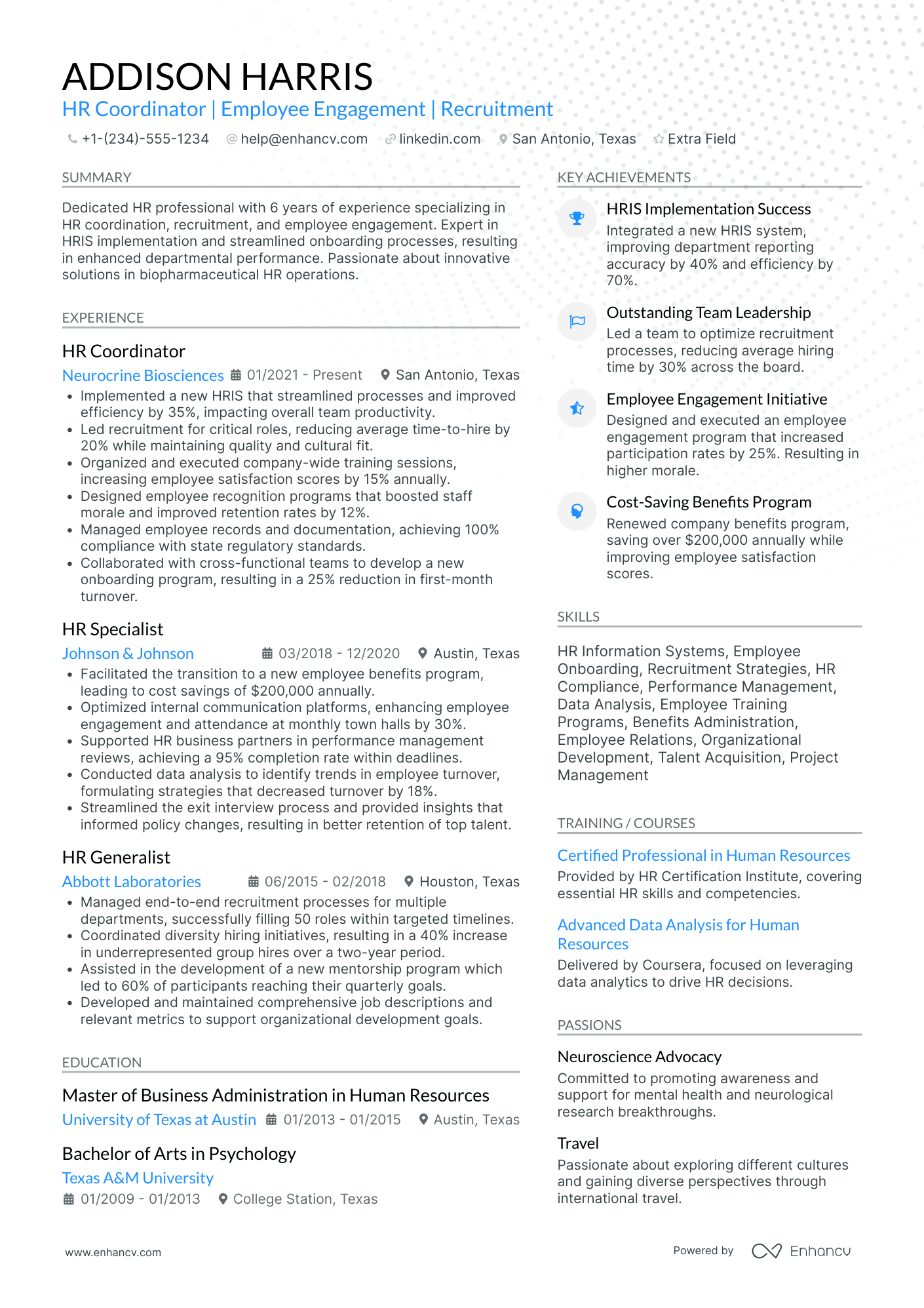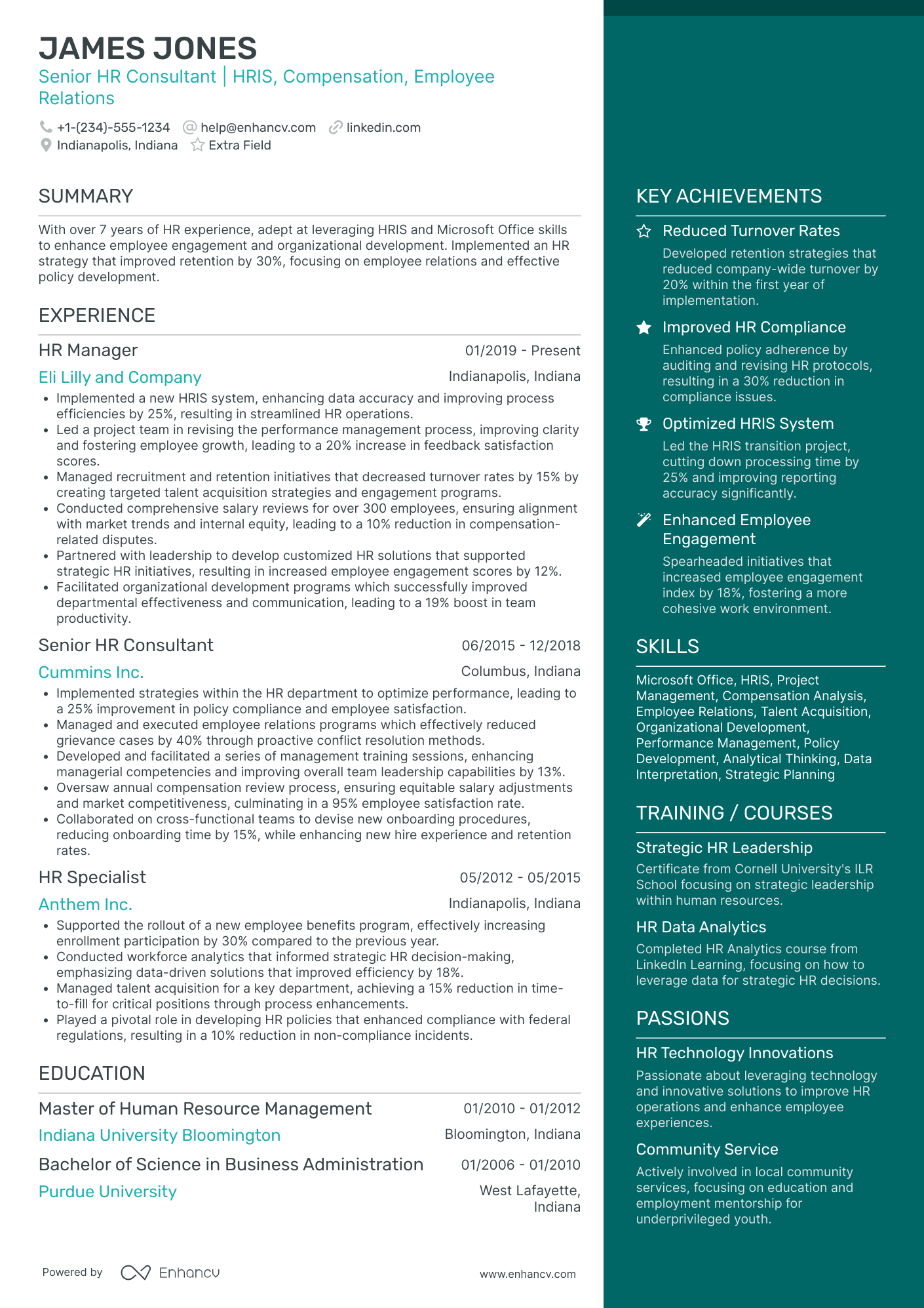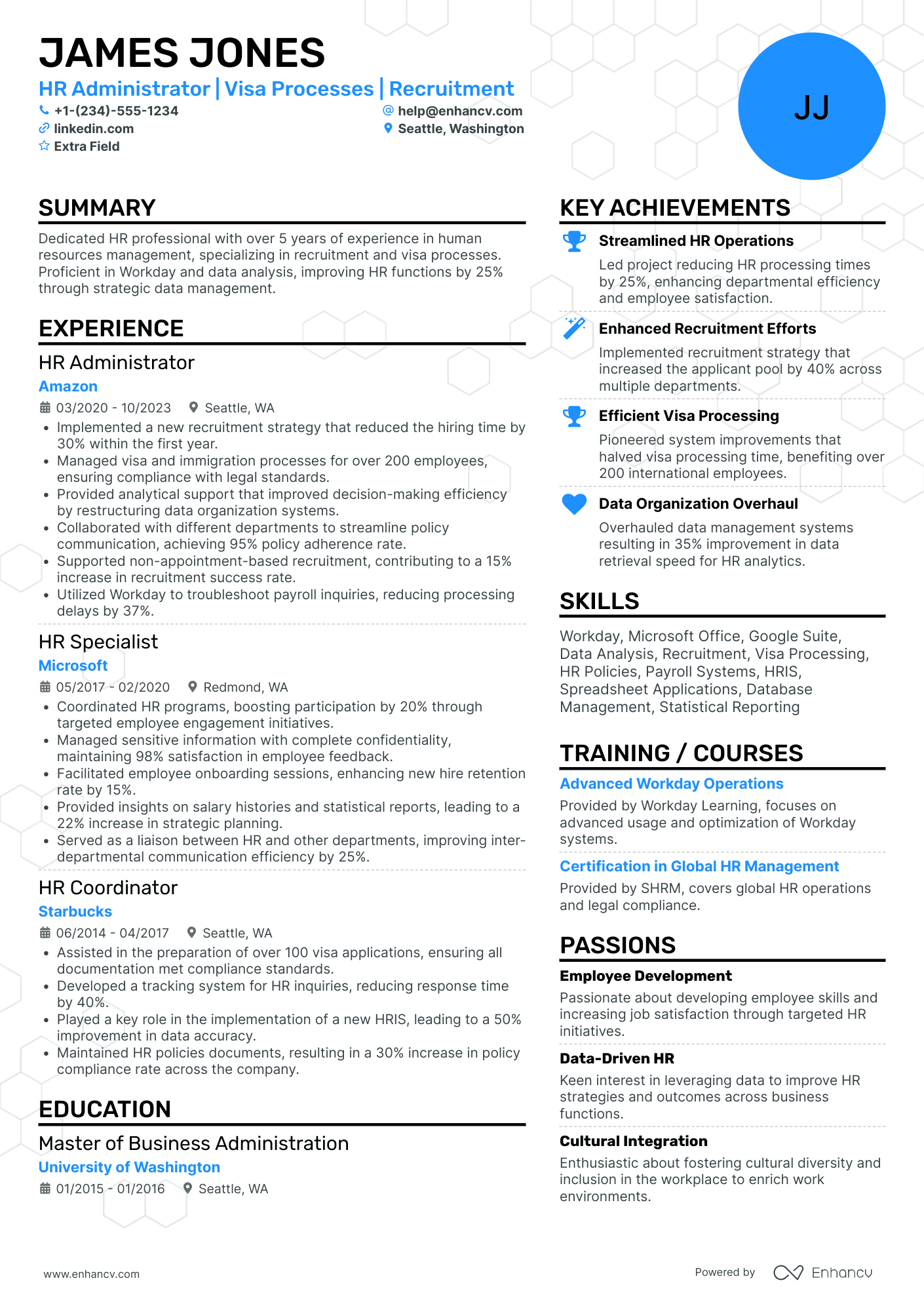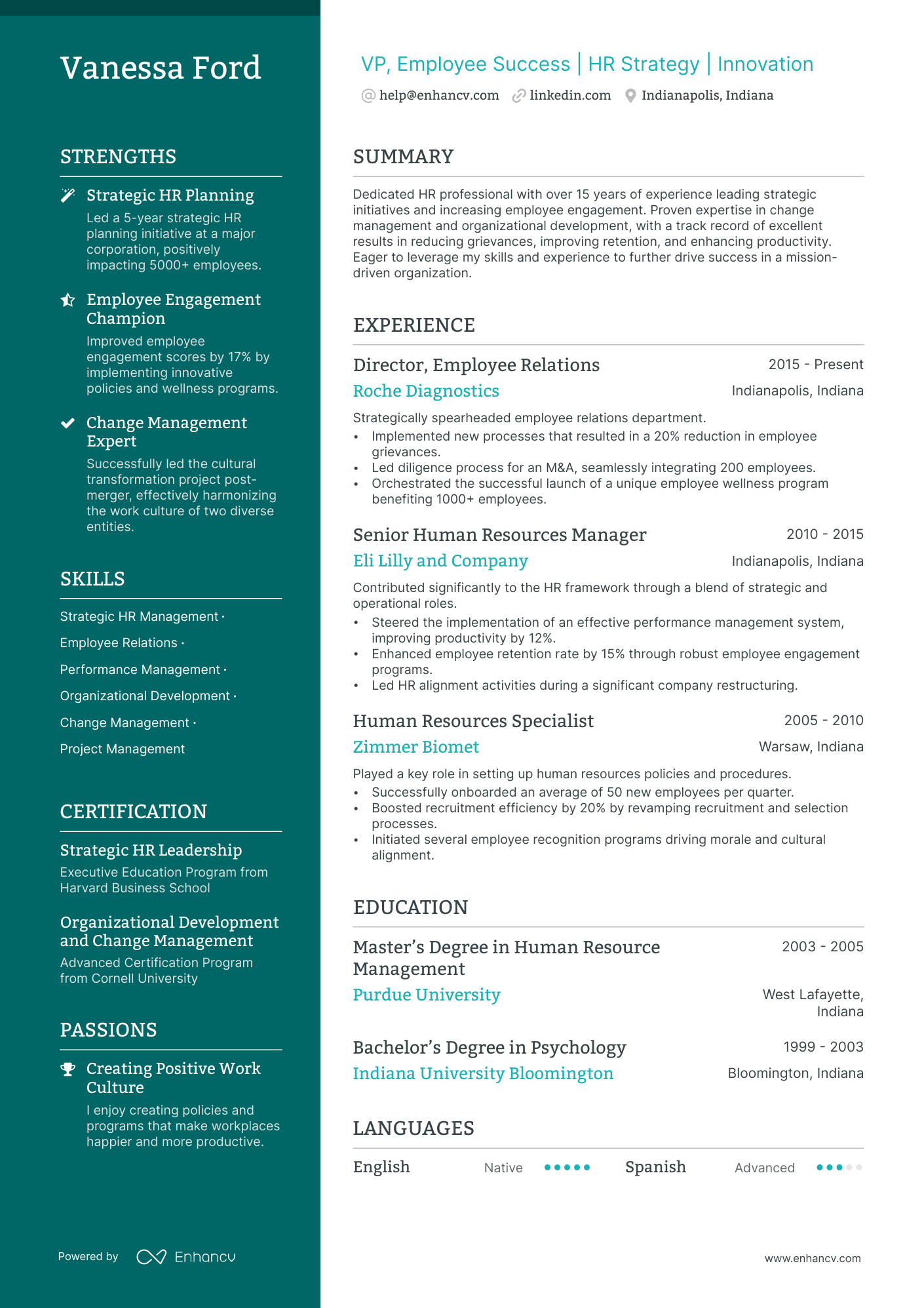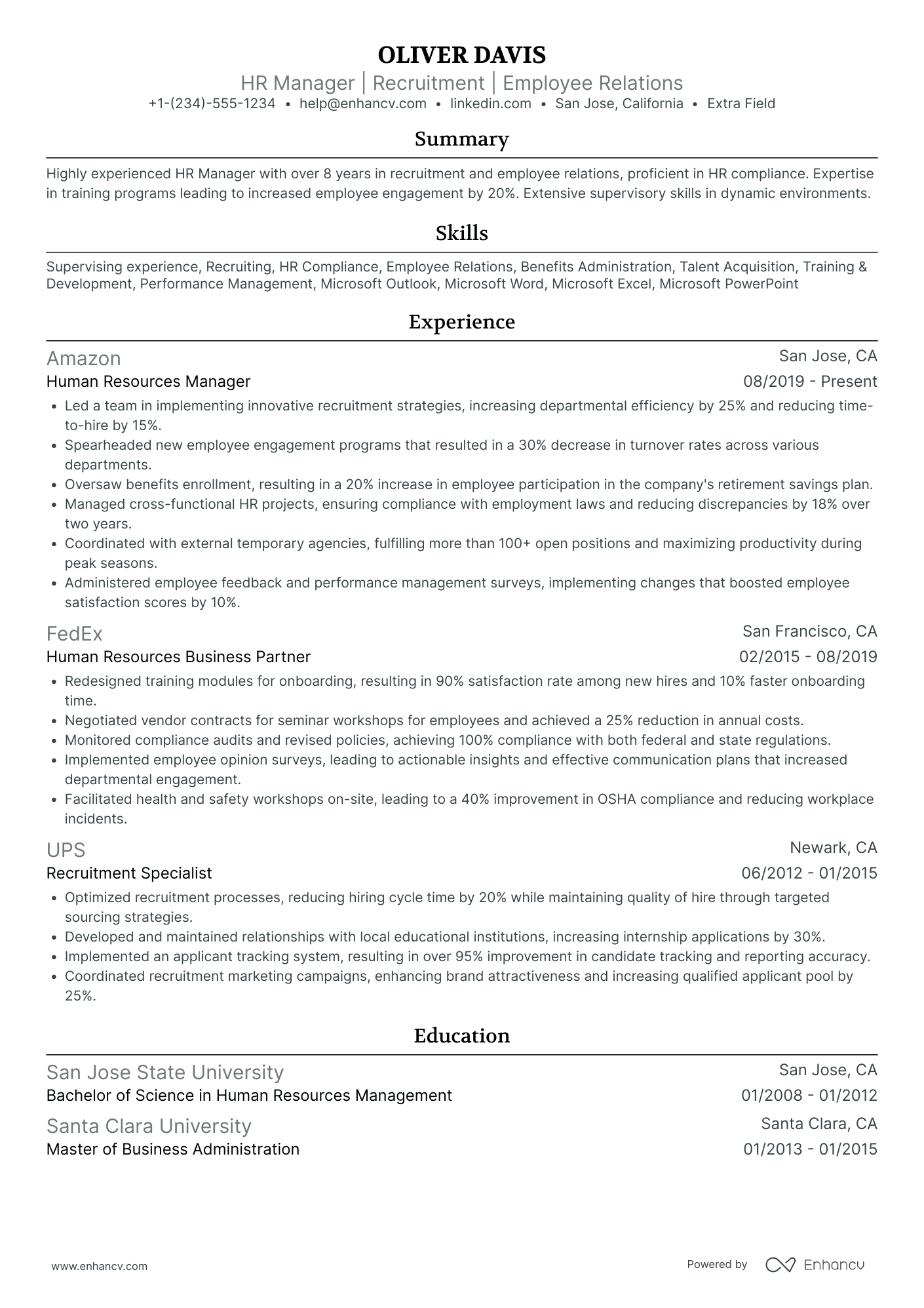Finding yourself on the other side of the hiring process can feel a bit strange. You've been the one making hiring decisions, and now you’re the one looking for a job. But don’t sweat it! The good news is that HR specialist jobs are expected to grow by 6% from 2022 to 2032, faster than the average for all jobs. So, opportunities are definitely out there. With a top-notch resume, you’ll be back in the hiring seat before you know it!
Let us help you with this. Here’s what our human resources resume guide will teach you:
- How to choose a modern and professional resume template for human resources.
- How to present past job experiences in alignment with HR positions.
- How to feature key skills on a resume for a human resources position.
- How to underscore important certifications relevant to human resources.
- How to include additional sections to boost your HR resume.
If the HR resume isn't the right one for you, take a look at other related guides we have:
- Transition Manager Resume Example
- HR Analyst Resume Example
- HR Generalist Resume Example
- Talent Manager Resume Example
- HR Business Partner Resume Example
- Contracts Manager Resume Example
- HR Director Resume Example
- Continuous Improvement Manager Resume Example
- District Manager Resume Example
- Recruiter Resume Example
How to format a human resources resume
Your resume's format, structure, and design are essential in making a strong first impression. These elements are not just about aesthetics, they are vital for effectively communicating your professional story.
In human resources roles, as in any profession, there are varying levels of experience and education. Your resume should reflect the job and experience you have.
Here are 3 main resume formats to consider:
- Reverse chronological resume: Ideal for HR professionals with a solid work history, this format lists experience starting from the most recent job and working backward. If you have a progressive career path with consistent achievements in HR roles, the reverse-chronological resume can underline your growth and expertise effectively.
- Functional resume: Human resources professionals transitioning careers, with employment gaps, or early in their HR careers might benefit from a functional layout. This format focuses on skills and accomplishments rather than job chronology, allowing you to highlight relevant competencies and achievements irrespective of job sequence.
- Hybrid resume: Combining elements of both reverse-chronological and functional formats, this hybrid layout allows human resources professionals to show key skills and accomplishments upfront, followed by a concise work history.
To catch the eye of recruiters, organize your resume with these practical tips.
- Bet on a modern template to maintain a tidy layout. For example, a double-column template is a popular choice for many roles, including HR.
- Select professional fonts like Rubik, Lato, or Times New Roman, with font sizes between 10 and 12 points.
- Limit the resume to one page for early or mid-level careers. A two-page resume is suitable for more experienced professionals.
- Set 1-inch margins to maintain a neat and organized appearance.
- Feature your name, phone number, location, and professional email address in the header of your resume.
- Include a photo only if the job ad requests one and don't forget to save the resume as a PDF to ensure consistent formatting across platforms.
Study says that job seekers with up-to-date LinkedIn profile links are 71% more likely to get interviews, but under half include this link.
By following these tips, your resume will perform well in ATS systems and attract recruiters.
Don't miss the chance to give your resume an edge with our intuitive AI resume checker, which provides a free, detailed 16-point assessment.
Is your resume good enough?
Drop your resume here or choose a file. PDF & DOCX only. Max 2MB file size.
With the format finalized, we’ll create resume for human resources that catches recruiters’ eyes, focusing on:
The top sections on an human resources resume:
- Contact information: It's crucial because it enables recruiters to get in touch.
- Professional summary: It gives a quick overview of your HR skills and qualifications.
- Work experience: This part is important as it highlights your prior professional experiences in the HR field.
- Skills and competencies: Human resources is a skill-intensive role and demonstrating your skills is key.
- Education and certifications: This section is necessary as it showcases your formal training and education in human resources.
You probably already know, but we’ll refresh your memory about what recruiters look for in these sections of your human resources resume and how they evaluate your qualifications.
What recruiters want to see on your resume:
- Experience in the field: This shows that candidates have a solid foundation in human resources practices.
- Knowledge of employment law: It's essential since HR professionals frequently interact with these legal parameters.
- Interpersonal skills: These are important as human resources roles require a lot of interaction and effective communication.
- Problem-solving abilities: This is prioritized as HR professionals often have to resolve workplace issues.
- Certifications: They demonstrate a commitment to the HR field and up-to-date knowledge of best practices.
Great vision without great people is irrelevant. HR’s role is to ensure we have great people.
Jim Collins
Typically, the experience section comes first in any resume format. We’ll help you tailor it for a HR resume below.
How to write your human resources resume experience
As an HR specialist, you likely know what works and what doesn't in experience sections. Still, we'll dive even deeper to give you more helpful resume tips. Your experience section is key to presenting your HR skills, successes, and the value you can add to a new position.
Here are some steps to help you develop an impactful experience section:
- Focus on HR-related experience and list the company name, a brief overview, and the employment dates, followed by up to six bullet points per role.
- Emphasize tangible results from your work in each role, using numbers or percentages to showcase your impact.
- Utilize action verbs to clearly and dynamically describe your responsibilities.
- Highlight your most important and relevant achievements in each job's description.
Let's take a look at a specific human resources job description to better tailor your experience section.
Job title: HR Generalist
Job description:
We are seeking a motivated and proactive HR generalist to join our Human Resources team. The HR generalist will play a key role in supporting various HR functions and initiatives, partnering closely with managers and employees across the organization. This position offers an exciting opportunity for someone looking to develop their HR skills and contribute to the overall success of our company.
What you will do
- Provide support to the SR. HR Business Partner in delivering a wide range of HR services, including but not limited to employee relations, performance management, talent acquisition, onboarding, and offboarding processes.
- Assist in the development and implementation of HR policies, procedures, and programs in alignment with company goals and regulatory requirements.
- Assist in immigration operations in terms of reviewing and verifying work permits, collecting & maintaining up-to-date records, communicating effectively with employees and managers regarding immigration issues and systematic records
- Act as a resource for employees regarding HR-related inquiries, policies, and procedures, ensuring timely and accurate responses.
- Collaborate with cross-functional teams to address employee relations issues, conflicts, and performance management matters in a fair and consistent manner.
- Assist in organizing and facilitating employee training and development programs, including orientation sessions, compliance training, and professional development initiatives.
- Maintain accurate and up-to-date employee records and HR databases, ensuring compliance with data privacy regulations and confidentiality standards.
- Contribute to HR projects and initiatives aimed at enhancing employee engagement, retention, and organizational effectiveness.
Requirements:
- Bachelor's degree in Human Resources, Business Administration, or related field.
- 2-4 years of experience in HR or related roles preferred.
- Strong understanding of HR principles, practices, and employment and immigration laws.
- Excellent interpersonal and communication skills, with the ability to interact effectively with employees at all levels of the organization.
- Detail-oriented with strong organizational and multitasking abilities.
- Proactive problem-solver with a customer service mindset.
- Ability to maintain confidentiality and handle sensitive information with discretion.
- Proficiency in Microsoft Office Suite and HRIS systems.
Considering this job posting, let's review both a strong and a weak example of how to tailor your experience entries to it.
First, let's take a look at an experience section that could use some improvement.
- •Managed employee records and ensured data accuracy.
- •Conducted recruitment processes, including interviewing and onboarding.
- •Developed and implemented HR policies and procedures.
- •Utilized HR software tools for efficient employee management.
This experience section listed here isn't customized to fit the job posting above. Plus, it’s too vague and lacks the specific details that make a resume appealing to HR recruiters. It doesn't clearly convey the impact or scope of the candidate's responsibilities. Simply stating tasks like "managed employee records" or "conducted recruitment processes" doesn't demonstrate the candidate's effectiveness or the complexity of their role.
You know you can improve this. The second applicant can as well.
Now, let's check out an upgraded version of the same experience entry.
- •Supported Sr. HR Business Partner, resolving 95% of employee issues and improving performance management.
- •Assisted in recruitment processes, including interviewing, onboarding, and offboarding, achieving a 30% reduction in time-to-hire.
- •Reviewed and verified work permits, maintaining up-to-date immigration records with a 100% compliance rate.
- •Acted as a resource for HR inquiries, ensuring 12-hour response time.
- •Collaborated to address employee issues, reducing conflict resolution time by 20%.
- •Organized and facilitated employee training and development programs, including compliance training, resulting in a 90% employee satisfaction rate.
The updated experience section works well for HR roles because it includes:
- Measurable achievements: The bullet points include specific, quantifiable results such as "resolving 95% of employee issues," "achieving a 30% reduction in time-to-hire," and "maintaining a 100% compliance rate with immigration records." This quantification is needed to prove the impact of the work done.
- Action verbs: The use of dynamic verbs like "supported," "organized," "reviewed," and "collaborated" portrays each task as proactive and impactful.
- Demonstrated soft skills: The description implies critical skills for the job. For example, resolving employee issues and improving performance management highlight problem-solving and organizational skills. Additionally, ensuring a 12-hour response time for HR inquiries and achieving a 90% employee satisfaction rate in training programs demonstrate reliability and a strong commitment to employee development.
The updated entry clearly demonstrates what the candidate can do. It aligns the work history with job demands, developing a targeted resume that passes ATS scans and captures the interest of hiring managers.
How to quantify impact on your resume
Concrete figures and percentages always make a strong impact. They can effectively depict the impact of your human resources initiatives on company success. This strategy highlights your measurable contributions, such as boosting employee engagement or optimizing performance management.
The following are some suggested ideas we’ve come up with to illustrate your accomplishments in prior HR positions.
- Include the percentage of employee turnover reduction you've achieved: This metric showcases that you can maintain a stable workforce, essential to the business.
- Underline the diversity percentages improved during your tenure: It demonstrates your ability to build a diverse and inclusive work environment.
- Feature the rate of successful hiring processes you've implemented: This confirms that you can identify and attract top talent effectively.
- Specify the number of employee training programs developed: It emphasizes your dedication to staff development and long-term investment in personnel.
- Detail cost savings in HR operations you've contributed to: Reducing operation costs is a key concern that will grab a recruiter's attention.
- Indicate the increase in employee satisfaction under your management: It reflects your talent for creating a positive workplace culture.
- List the amount of process improvements you've instigated: This can demonstrate initiative and a proactive approach to bettering the company.
- Mention numbers reflecting streamlined HR services: It shows efficiency and your focus on optimizing HR operations for the benefit of the company.
How do I write an human resources resume with no experience
What you lack in experience, you can make up for with enthusiasm, skills, and a willingness to learn.
Richard Branson
While direct experience is important, there are numerous ways to make your application shine and demonstrate your potential to employers.
Here are some strategies to enhance your HR job application, even without prior work experience:
- Emphasize your education: Highlight your academic achievements, relevant coursework, and any projects completed during your studies. This shows your foundational knowledge and skills.
- Showcase relevant projects and competitions: Mention any HR-related projects, case studies, or competitions you have been involved in. Provide details on your role, the tools you used, and the outcomes you achieved.
- Earn certifications: Pursue certifications in HR areas such as SHRM-CP or PHR. Additionally, take online courses to build skills and prove your commitment to continuous learning.
- Gain experience through internships: Internships, whether paid or unpaid can provide valuable practical experience. Include any relevant work, even if it wasn’t a formal job.
- Join HR organizations or clubs: Participate in HR clubs or professional societies like SHRM. This offers networking opportunities, resources, and experiences to enhance your resume.
- Show personal or freelance HR projects: Mention any HR-related projects you have been involved in. Provide details on your role, the tools you used, and the outcomes you achieved, including any freelance work you've done in HR to demonstrate your skills and initiative outside a traditional job setting.
- List references from educators or mentors: Include references from teachers or mentors who can vouch for your skills and character, or mention that they are available upon request. This adds credibility to your resume.
- Craft a clear objective statement: Begin your resume with a concise 3-4 sentence objective that reflects your passion for human resources and highlights any relevant experiences. This can prove your commitment and enthusiasm for the field.
- Customize your resume and cover letter: Tailor your resume and cover letter for each job application, focusing on the skills and experiences most relevant to the position.
The cover letter is the introduction and your resume is the details.
Lisa K. McDonald
Every HR professional begins somewhere. By underscoring your enthusiasm, skills, and willingness to learn, you can make a compelling case for yourself and secure that first HR job. Stay motivated and keep pushing forward—your opportunity awaits!
Now that we've reviewed your professional background, let’s focus on highlighting the hard and soft skills that make you a well-rounded and capable HR candidate.
How to list your hard and soft skills on your resume
There is no doubt that including skills on your resume is crucial, as it emphasizes your qualifications and helps recruiters determine your fit for the HR role. It helps align your profile with the job description, improves your resume's visibility in Applicant Tracking Systems, and demonstrates your value to potential employers.
Let’s start with hard skills.
Hard skills
Listing hard skills on HR resumes is vital as they demonstrate your technical knowledge and proficiency in specific tools and technologies.
Create a specific resume skills section labeled "Hard skills,” and place it near the top or below the work experience section. Be precise and relevant by naming specific tools, software, and methodologies you’re skilled in.
Adapt these skills to the job you’re applying for. If you possess numerous hard skills, consider categorizing them into different sections for better organization.
Here are 20 essential human resources skills that would significantly benefit your application.
Best hard skills for your human resources resume
- Employee relations
- HRIS (Human Resource Information Software)
- Talent management
- Conflict resolution
- ATS (Applicant Tracking Systems)
- Compensation and benefits planning
- Workforce planning
- Performance management
- Legal compliance
- Onboarding processes
- Payroll management
- Recruiting software
- HR policies and procedures
- Learning management systems
- HR program/Project management
- Diversity and inclusion initiatives
- Data analysis
- Knowledge of employment laws
- HR metrics
- Organizational development strategies
Let's now move to soft skills.
Soft skills
Soft skills are essential for your human resources resume as they illustrate your ability to work well with others and adapt to different situations. Rather than placing these skills in a separate section, weave them throughout your resume.
In your summary or objective, emphasize key soft skills and provide specific examples of how you've applied them in real-life situations, such as enhancing employee relations or addressing workplace disputes.
Additionally, underline relevant soft skills in your work experience and education sections, focusing on your teamwork and leadership in an HR setting. Ensure these skills match the keywords from the job ad.
Here are some commonly valued soft skills in human resources that our research has found.
Best soft skills for your human resources resume
- Communication
- Decision making
- Negotiation
- Empathy
- Leadership
- Critical thinking
- Problem-solving
- Teamwork
- Organization
- Adaptability
- Time management
- Active listening
- Relationship building
- Open mindedness
- Multitasking
- Persuasiveness
- Patience
- Stress management
- Diplomacy
Now, we'll focus on crafting education sections that show your academic achievements.
How to list your education and certifications on your resume
To enter the occupation, human resources specialists typically need a bachelor’s degree in HR, business, or a related field. Relevant degrees include human resources management, business administration, psychology, and labor relations.
A solid education in the field is crucial if you aim to climb the career ladder and aspire to become a manager someday. Having a strong educational background will undoubtedly be a significant advantage when crafting your HRM resume.
Your education section should emphasize coursework and training in areas critical to HR, such as employment law, organizational behavior, and compensation and benefits.
Here’s how to present the education section on your talent acquisition specialist resume:
- Degree title: List the degree you earned related to human resources or a relevant field.
- Institution name: State the name of the educational institution you attended.
- Graduation year: Mention the year you graduated or expect to graduate.
- Major: Highlight your field of study, such as human resources management or business administration, pertinent to HR roles.
- Relevant certifications: Provide details of your HR certifications, such as SHRM-CP or PHR.
- Additional training: Include any extra courses or workshops you’ve completed that boost your HR skills, like diversity training or advanced HR management.
- GPA: Consider listing your GPA if it exceeds 3.5 to emphasize your strong academic performance.
Here's the best way to outline your education on a resume for a human resources position.
- •Focused on advanced HR strategies and organizational development.
- •Conducted a research project on the impact of remote work on employee engagement and productivity.
- •Specialized in business management and organizational behavior.
- •Completed a capstone project focused on developing effective employee onboarding processes and improving workplace engagement.
In addition to a degree, obtaining relevant certifications can enhance your qualifications.
Showcasing your HR certifications on your resume emphasizes your credentials and commitment to continuous learning. Make sure to:
- List each certification you’ve earned.
- Identify the organization that granted each certification.
- Indicate the expiration date if relevant.
Consider these prestigious HR certifications.
Best certifications for your human resources resume
Now that this is clear, let's move on to customizing powerful resume summaries and objective statements that will grab the attention of potential employers.
MBA on your HR resume
If you have an MBA in HR, make sure it's easy for recruiters to see it on your resume. This degree shows you're ready to take on leadership roles and handle strategic challenges. It’s a great way to demonstrate you’re ready to make a significant impact at a high level.
When featuring your MBA in human resources on your resume, there are several strategic locations to consider to ensure it stands out to potential employers:
- Education section: This is the most common place to underline your MBA. List your degree, the institution, and your graduation year. For an MBA, it's also beneficial to include any relevant concentrations or specializations.
- Professional summary: Incorporate your MBA into your professional summary at the top of your resume to immediately communicate your qualification. This can be particularly effective if the job listing specifically requires or prefers a candidate with an MBA.
- Certifications: If you have additional space, or if your MBA is especially relevant to the job you are applying for, you can feature it in a dedicated section that lists certifications.
You’ve got a few good places to feature your MBA. Choose the one that best aligns with your overall resume layout and the specifics of the job you are applying for.
How to write your human resources resume summary or objective
When seeking an HR position, an engaging summary or objective can make your resume stand out. Both are crucial for quickly grabbing the recruiter's attention and demonstrating that you're a suitable candidate.
Here's the distinction:
- Summary: Offer a brief overview of your top professional accomplishments and relevant skills in 3 to 5 sentences. This is ideal if you have significant experience in HR.
- Objective statement: Keep it concise, around 3 sentences, focusing on your career aspirations and why you're interested in this position. This is beneficial if you're new to HR, transitioning careers, or re-entering the workforce.
Check out this great resume summary sample based on the earlier HR job ad. This one underscores the best way to draft your professional summary.
PRO TIP
A resume summary or objective is best crafted without a first-person narrative to keep it professional.
Next up, let's check out the case of an objective statement.
Follow these recommendations for developing a powerful resume summary or objective for an HR specialist job:
- Customize it: Tailor your summary or objective to the specific HR position and the company’s culture you’re targeting. Show how your skills meet their needs. For instance, "Accomplished HR Manager with 8 years of experience, adept at enhancing employee satisfaction and streamlining HR operations."
- Use specific metrics: Enhance your credibility by quantifying your achievements. For example, "Assisted in recruitment processes, achieving a 30% reduction in time-to-hire" or "Organized and facilitated training programs, resulting in a 90% employee satisfaction rate."
- Highlight technical skills: Emphasize critical HR skills, such as proficiency in HRIS systems like PeopleSoft and SAP SuccessFactors, as well as strong communication skills for effective employee relations and conflict management.
Investing time in crafting a precise and tailored summary or objective can make your resume significantly more impactful.
Additional sections for an human resources resume
As a person with experience in the field, you've probably noticed that candidates who share more about themselves on their resumes fit in better with the company. To make your HR resume more engaging, consider adding one or two of these extra sections to give recruiters a full picture of your skills and personality:
- Passions: Include your hobbies and activities, such as being part of a reading club or participating in writing classes, to present a well-rounded character.
- Language proficiency: List any languages you speak fluently to showcase your capability to work with diverse groups.
- Awards: Feature any recognitions you've earned in the HR sector, such as employee of the month, outstanding HR practices awards, or notable project contributions.
How to put a projects section on an human resources resume
This section highlights key HR projects, detailing their objectives, the strategies used, your role, and the outcomes achieved. It offers a clear view of each project's impact and success.
Here's an example:
- •Developed and implemented an employee engagement program that increased participation by 40% and improved overall job satisfaction by 25%.
- •Conducted comprehensive diversity and inclusion training, reaching over 200 employees and improving workplace inclusivity by 30%.
Including a projects section in your HR resume is a strategic choice because it highlights your hands-on experience and problem-solving abilities through real-world applications.
This section offers solid examples to bring up in interviews, demonstrating how you manage complex issues and work collaboratively. It’s an effective way to differentiate your resume and showcase your achievements in detail, which can benefit you during interviews—don’t overlook the importance of this section.
Key takeaways
Now that you've learned the basics, let's summarize the essential aspects of your HR resume:
- Maintain a tidy and professional layout using an appropriate resume format.
- Use specific metrics and numbers to enhance your credibility and showcase your impact in previous HR roles.
- Customize your resume for each human resources position, focusing on the skills and experiences most relevant to the job.
- Present your education, relevant coursework, and HR certifications to demonstrate your qualifications.
- Craft compelling resume summaries and objective statements to capture recruiters' attention.
- Include a projects section to highlight hands-on experience and real-world problem-solving abilities.
HR resume examples
By Experience
Human Resources Intern
Entry-Level Human Resources
Junior Human Resources
Senior HR Manager
Entry-Level HR Assistant
Mid-Level HR Specialist
Junior HR Analyst
Senior HR Director
By Role
